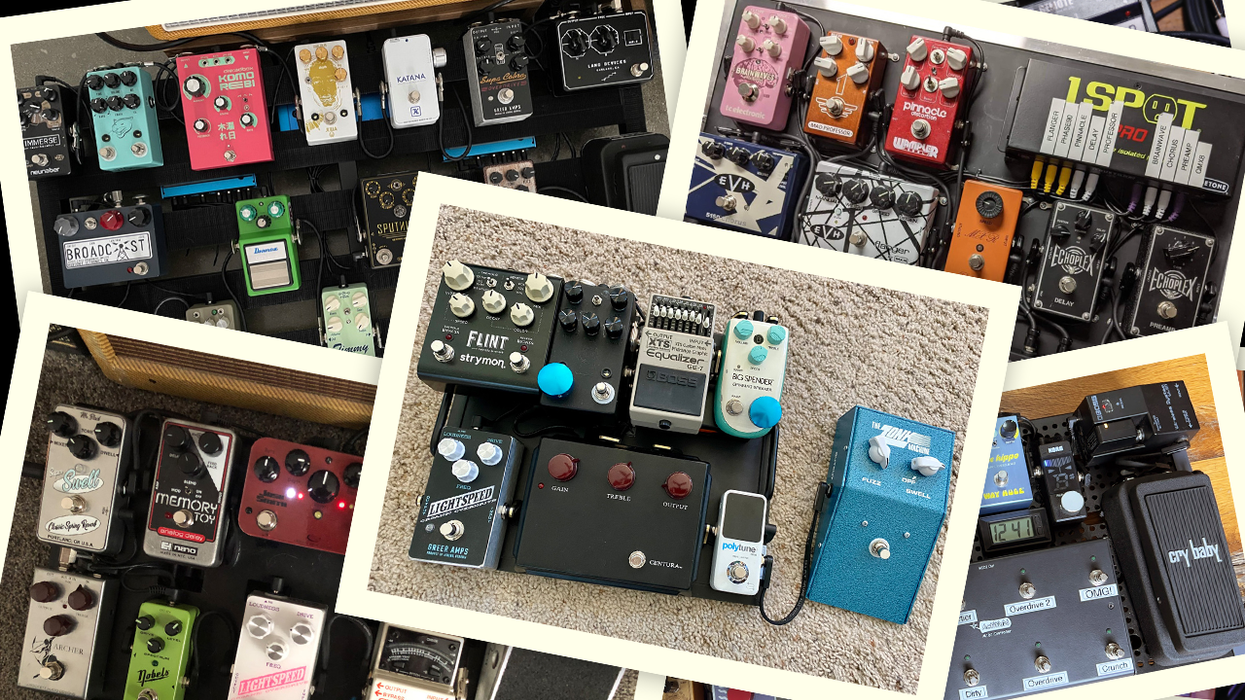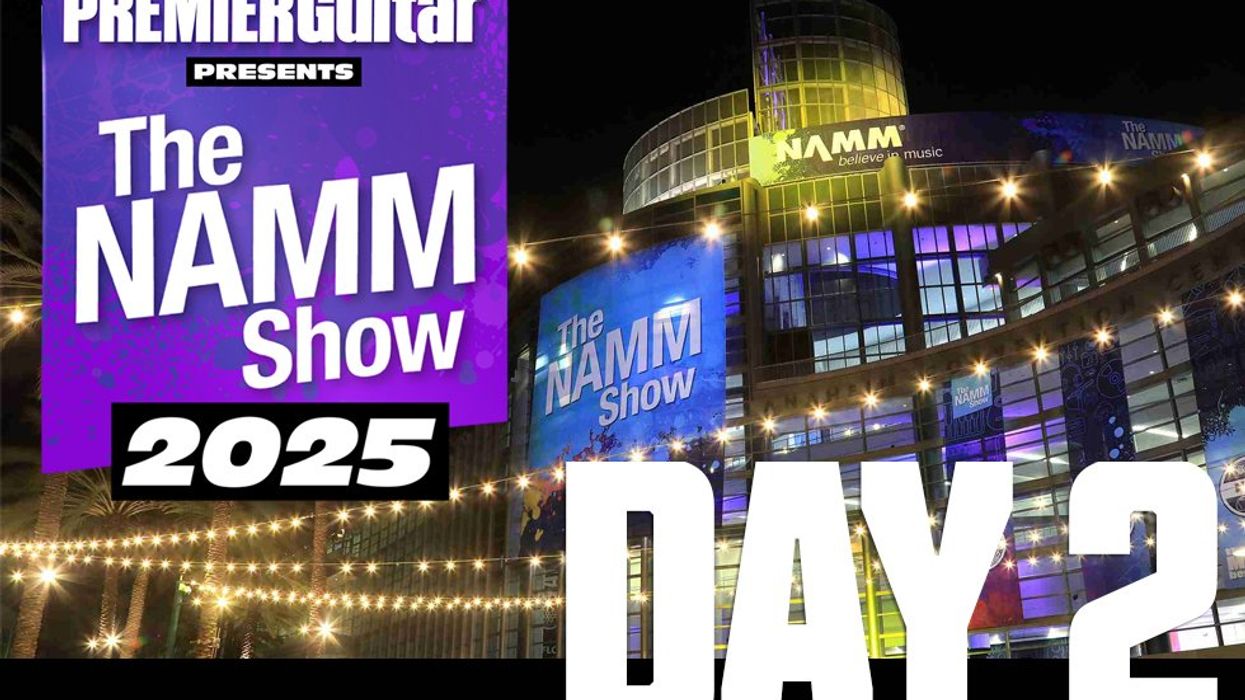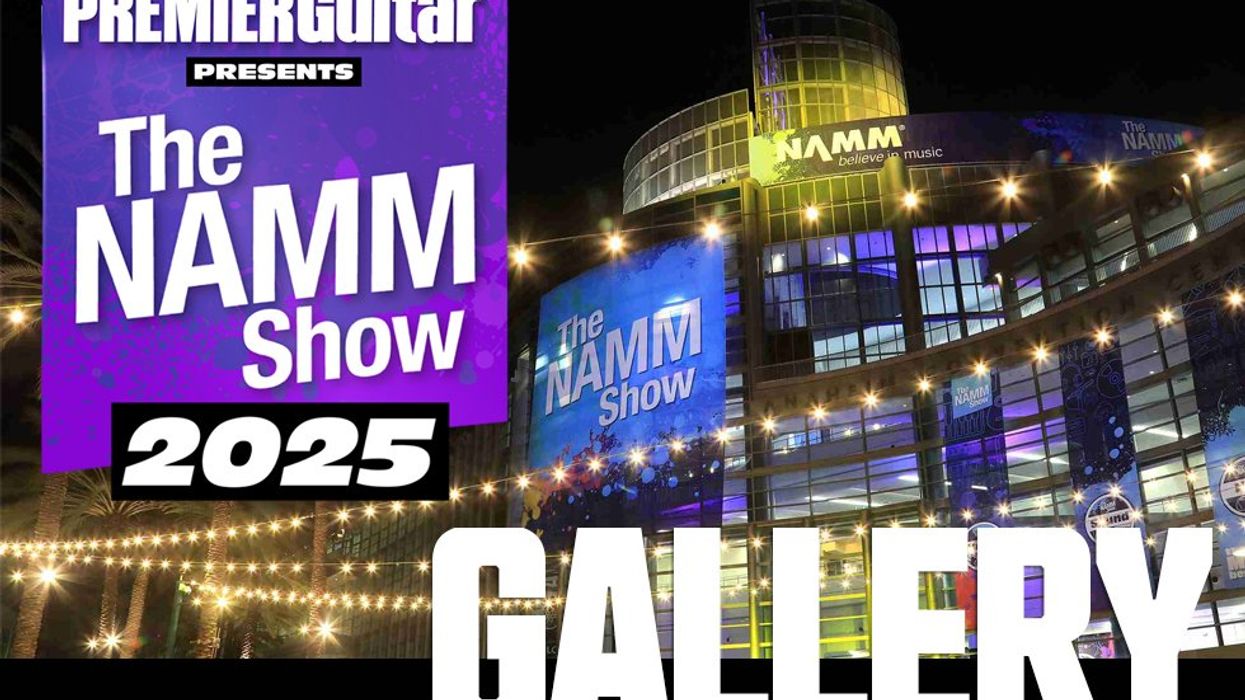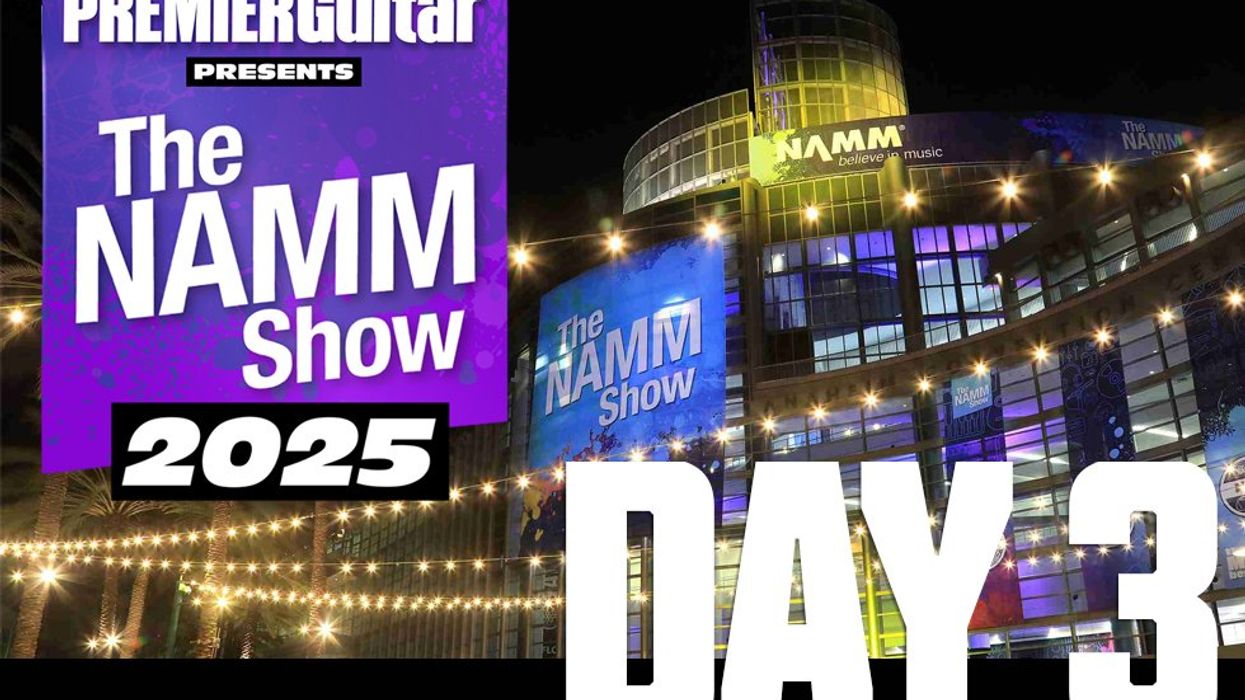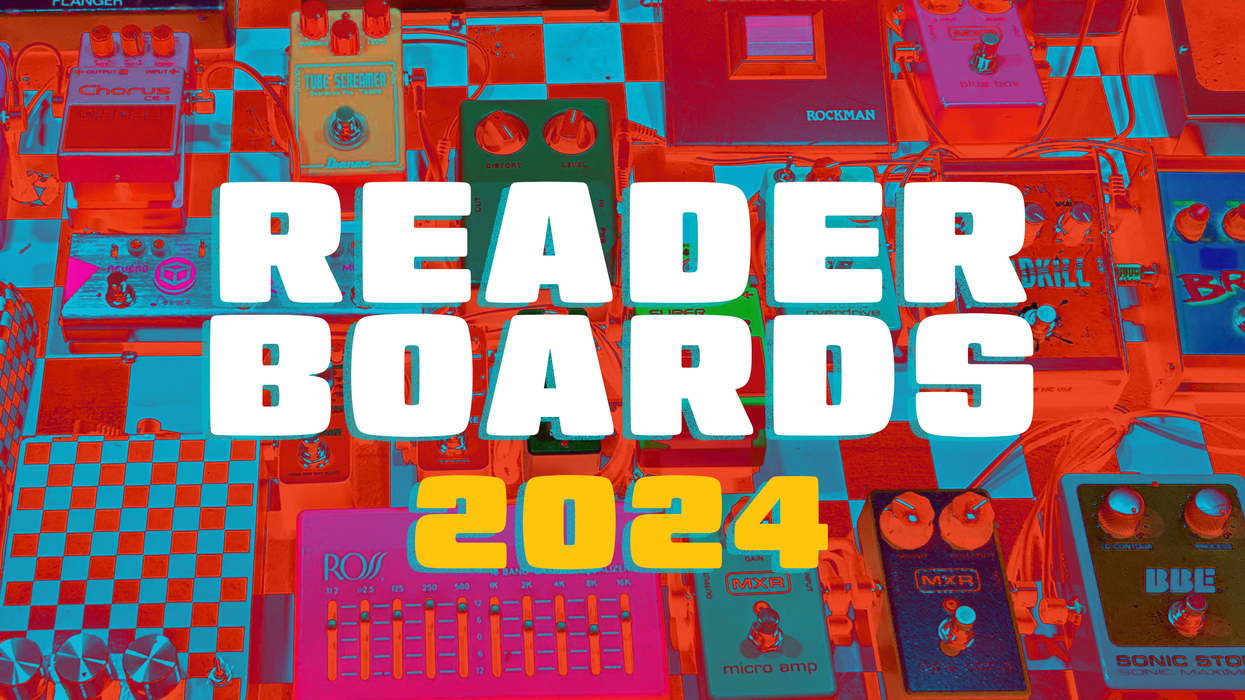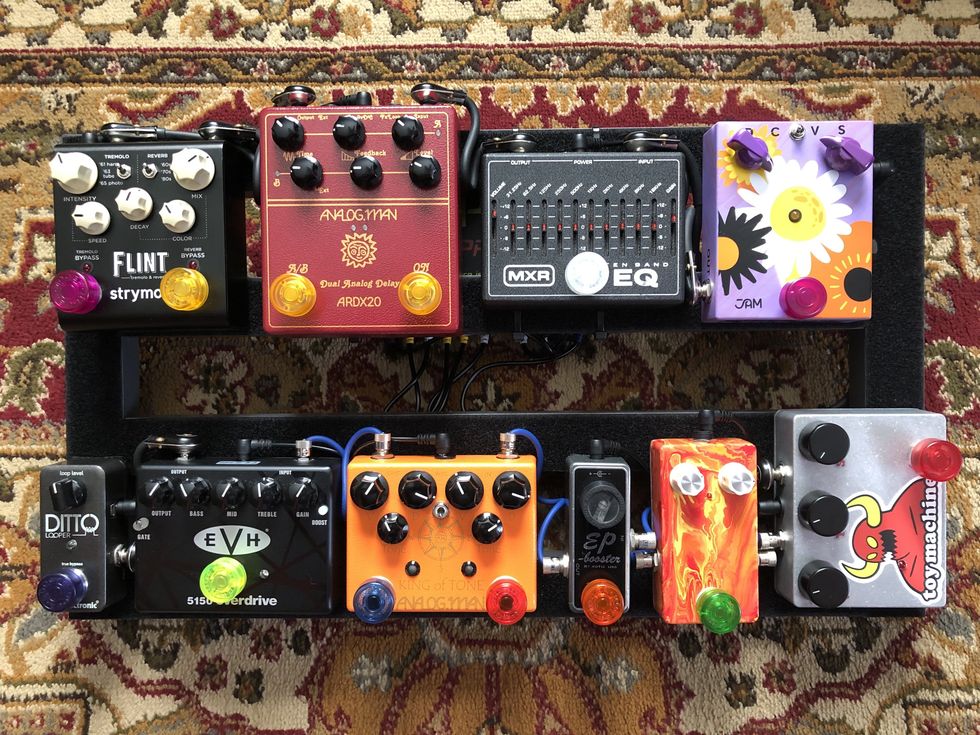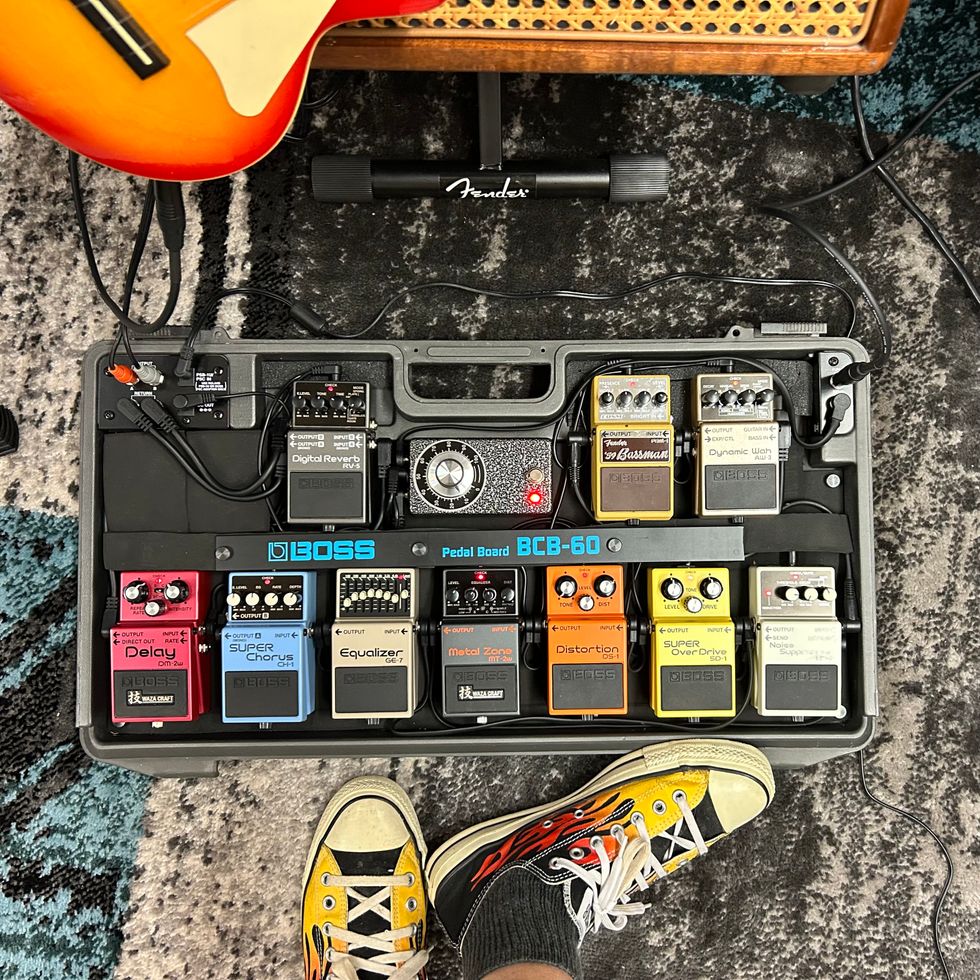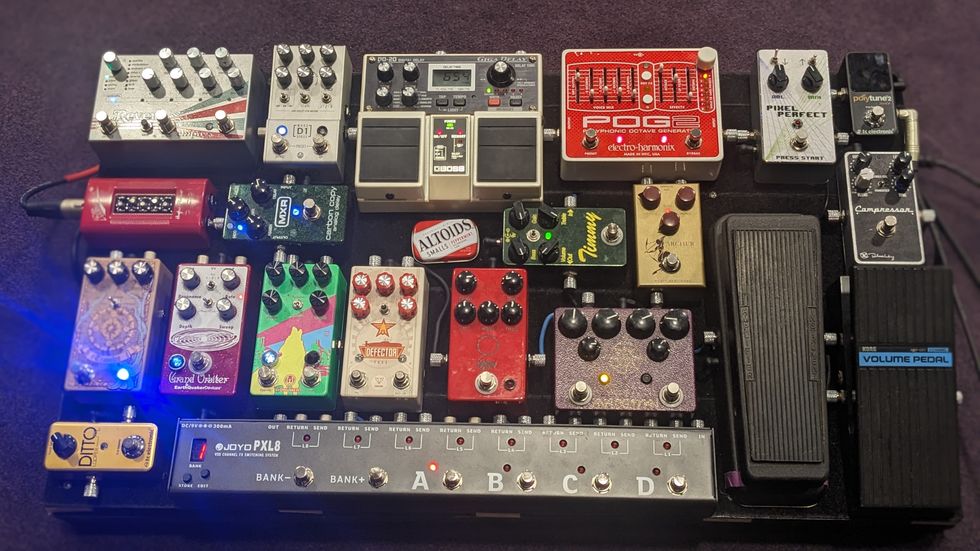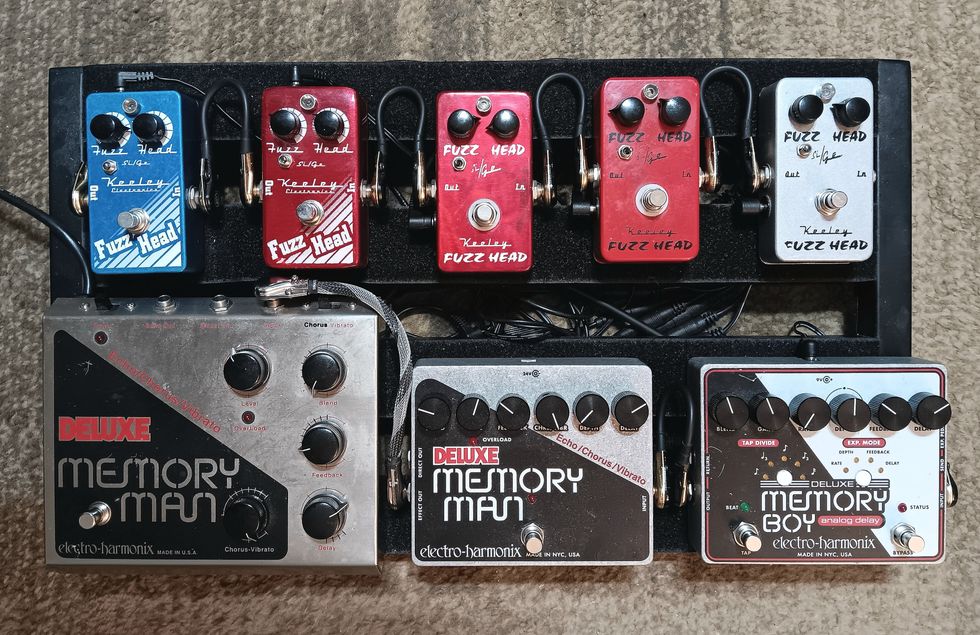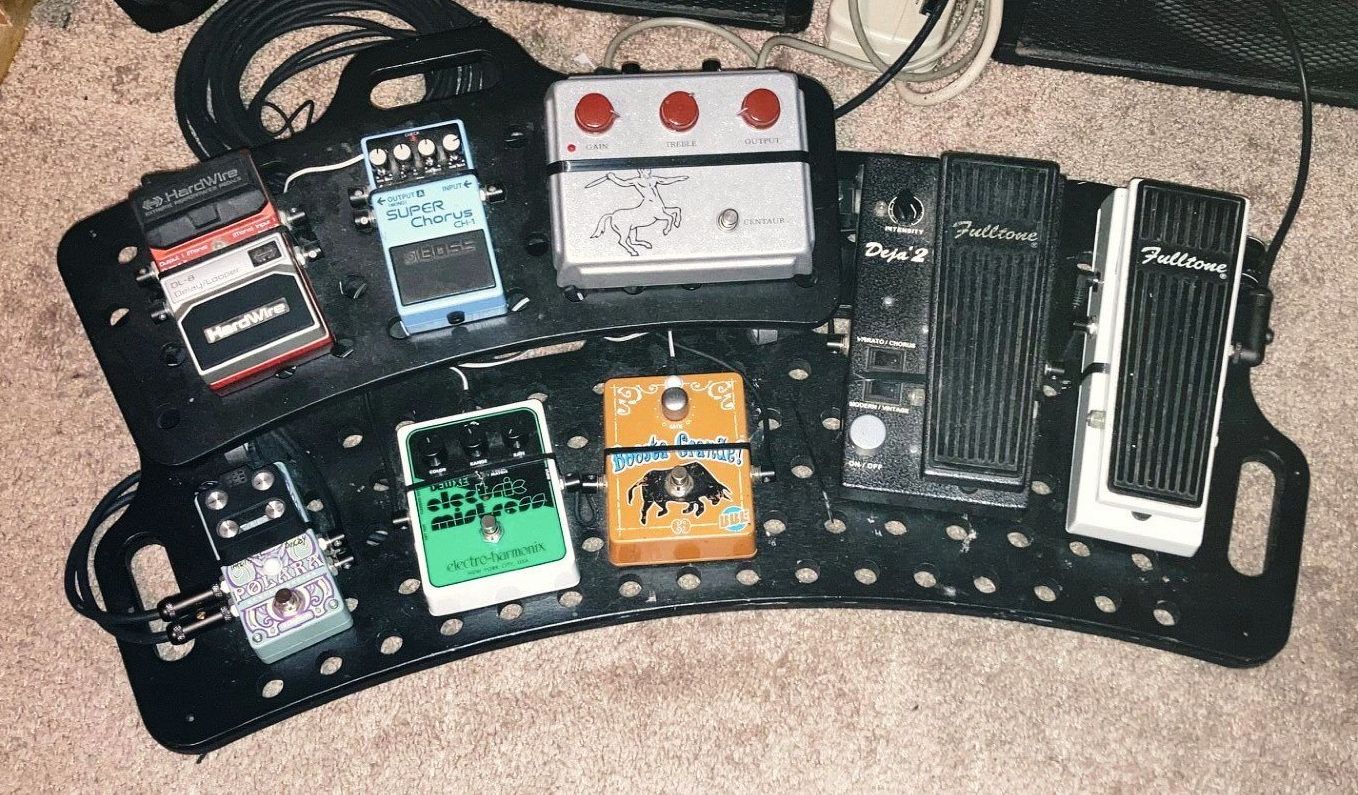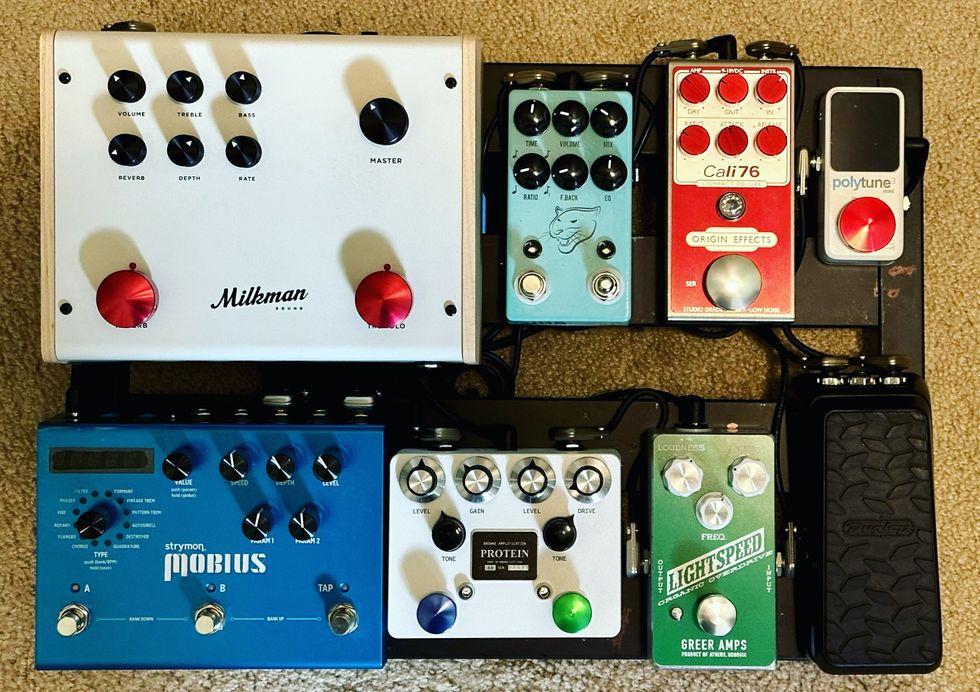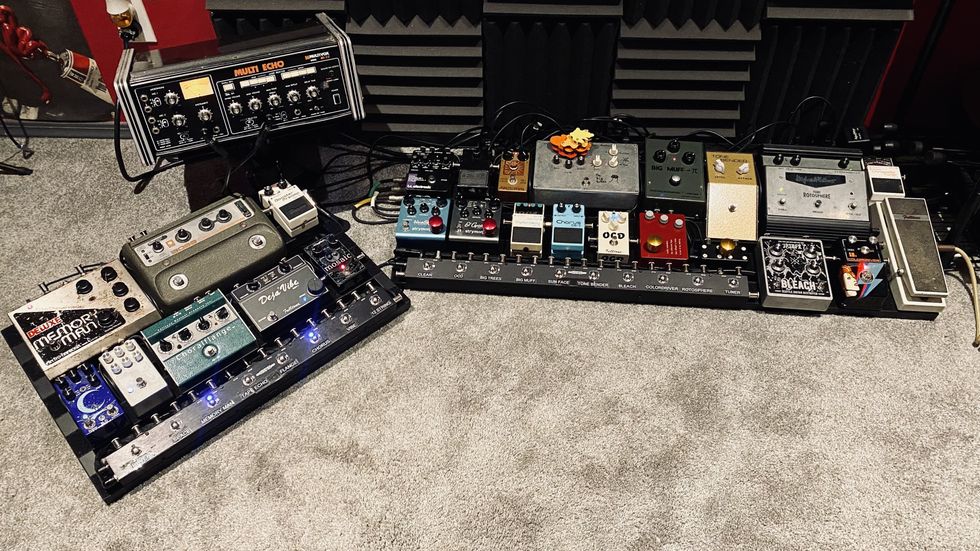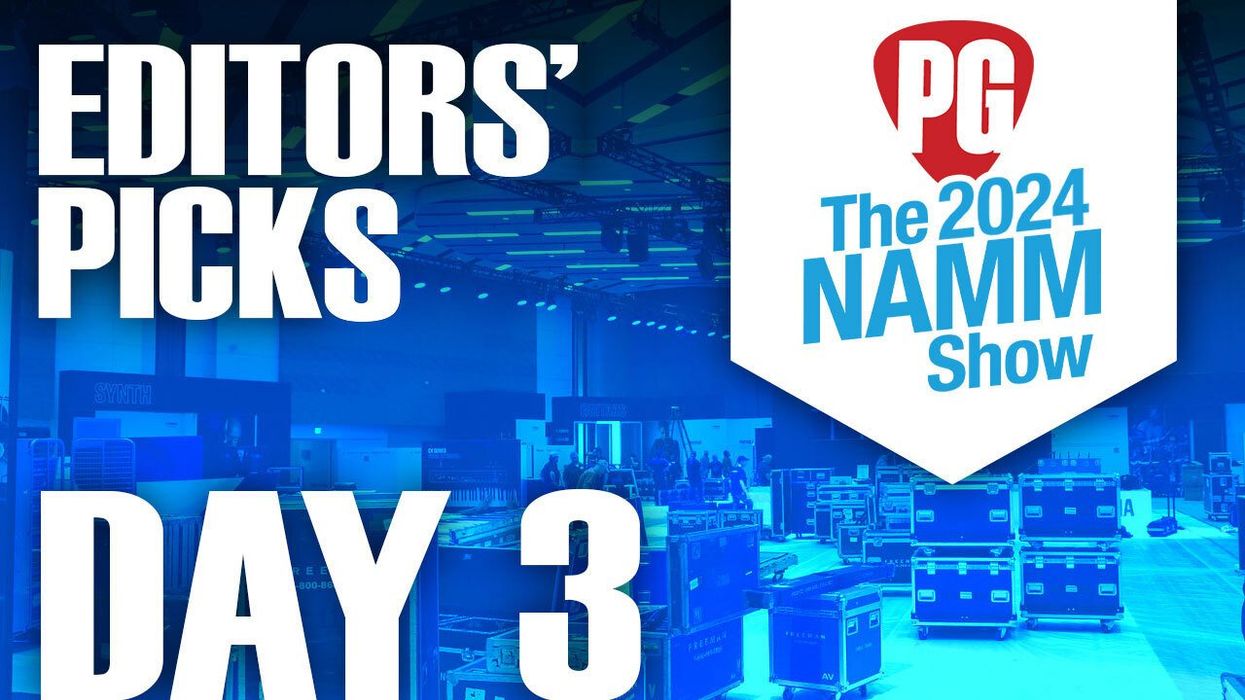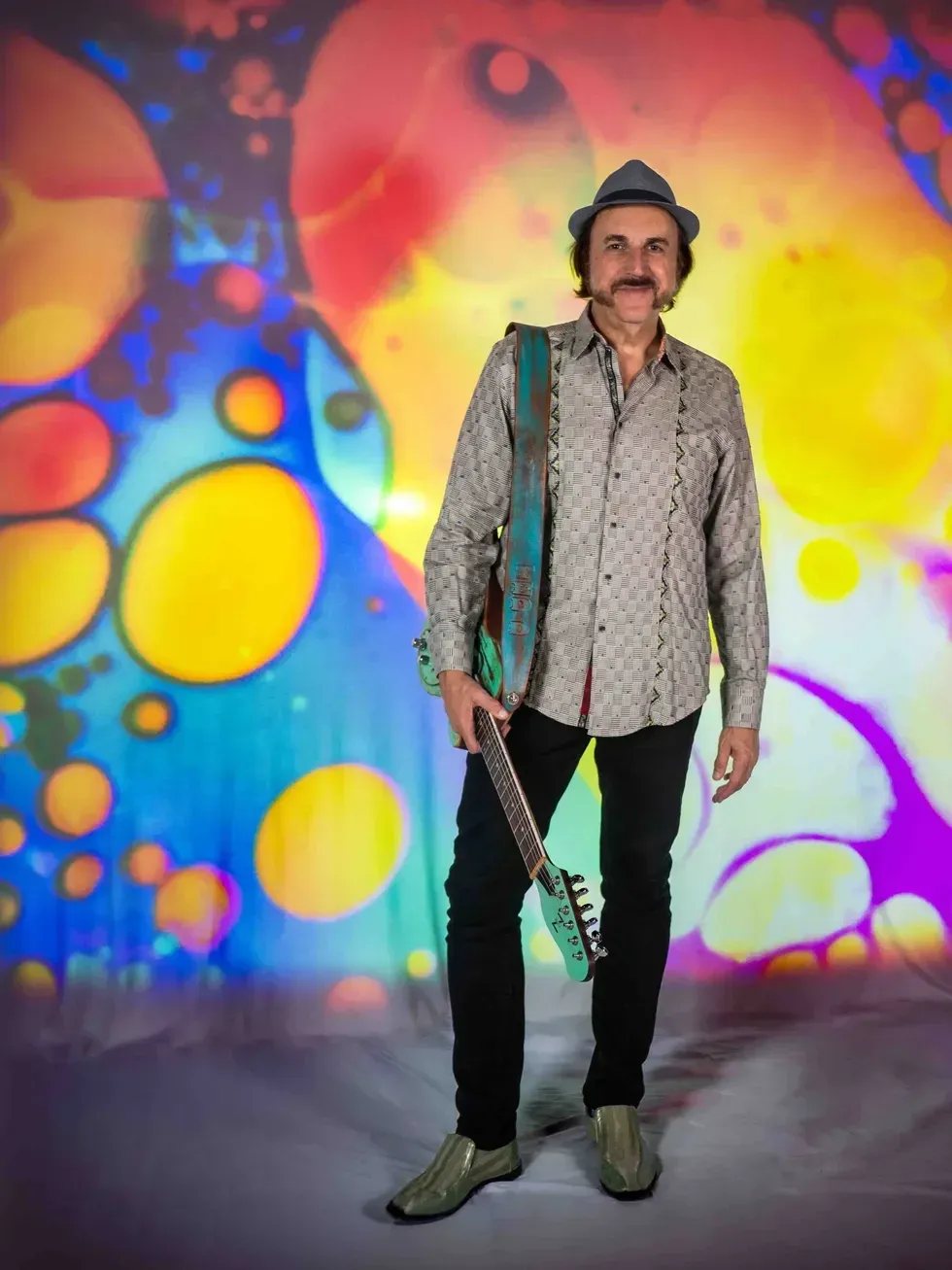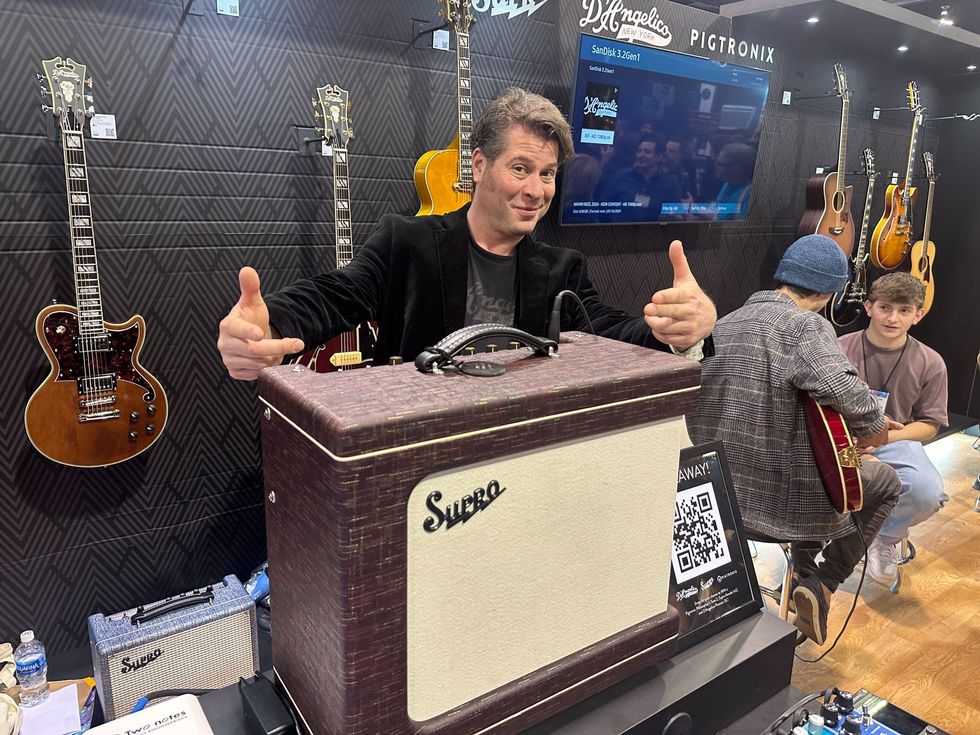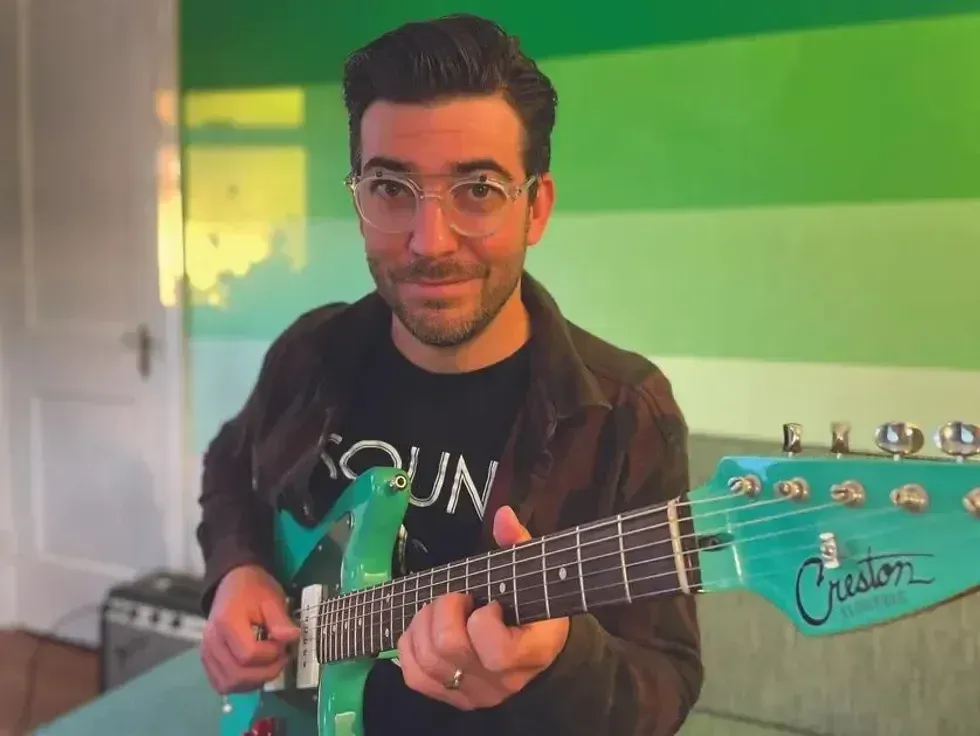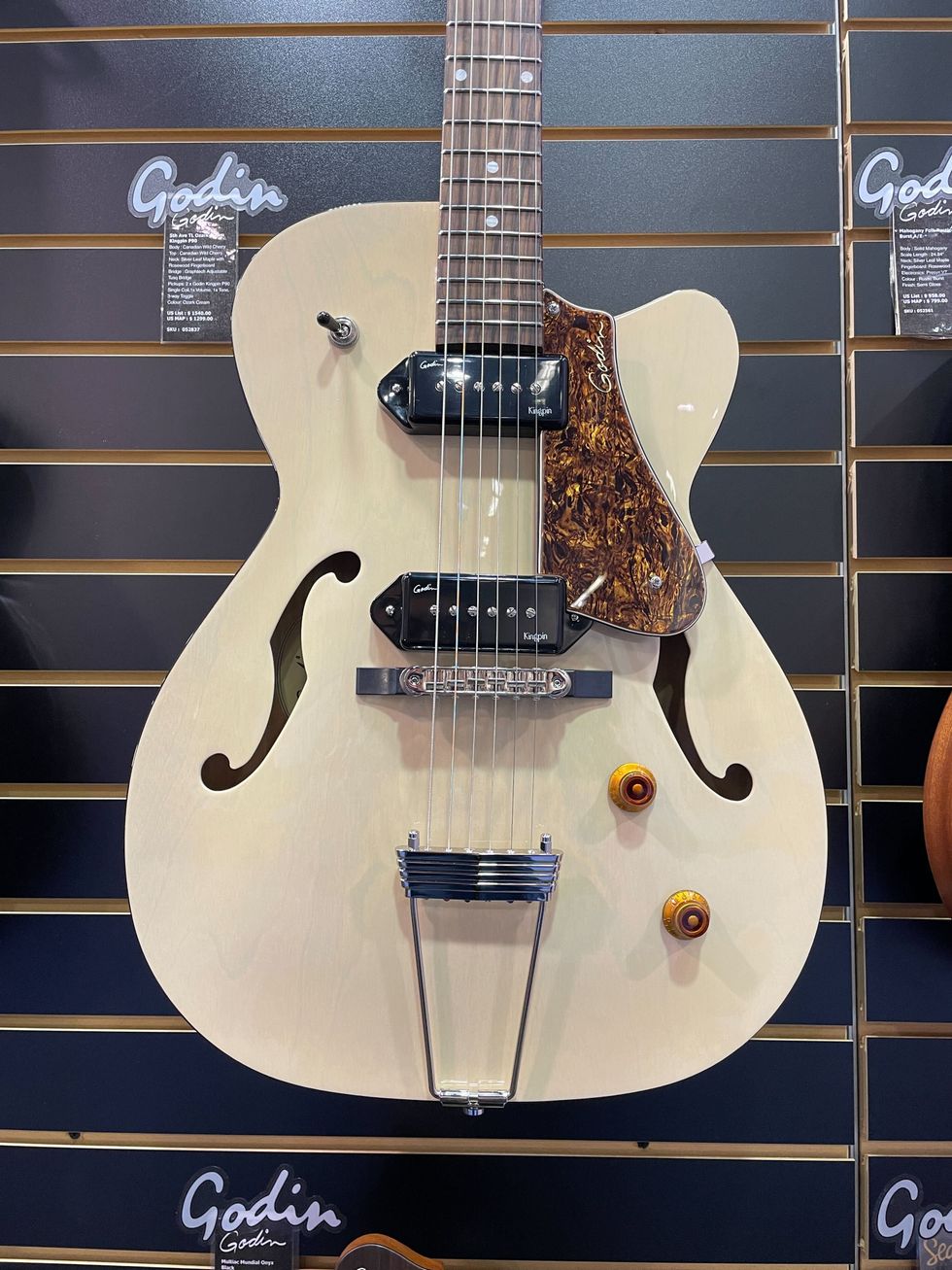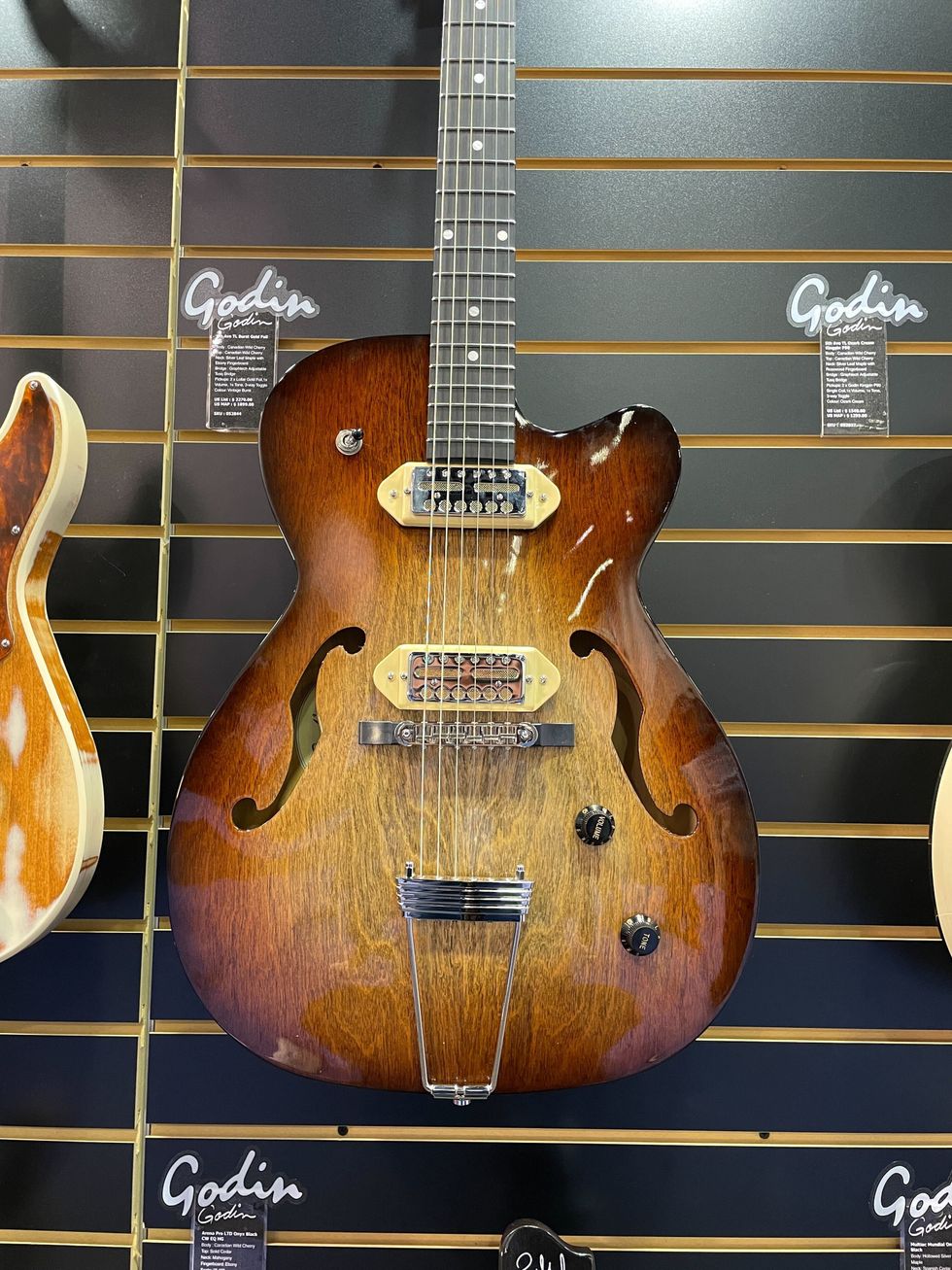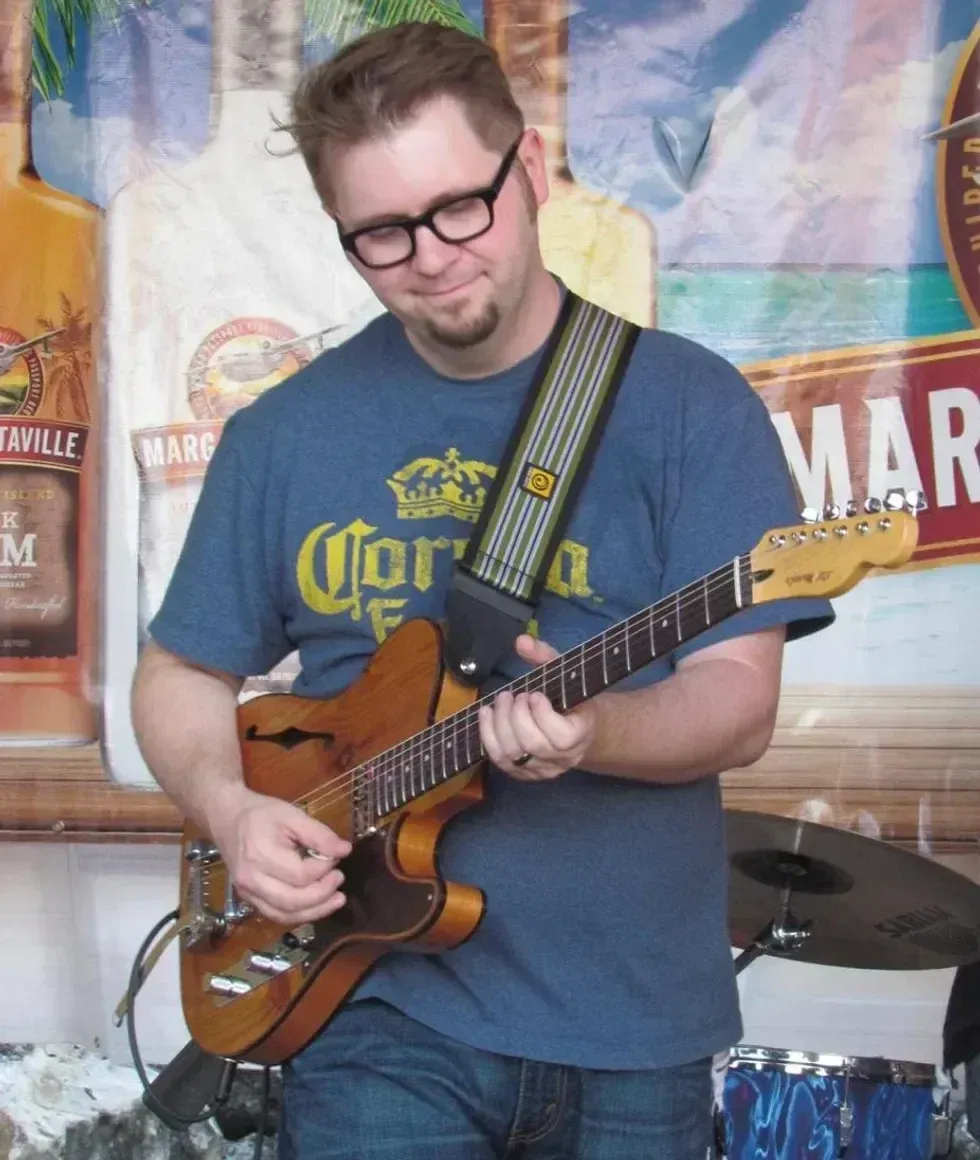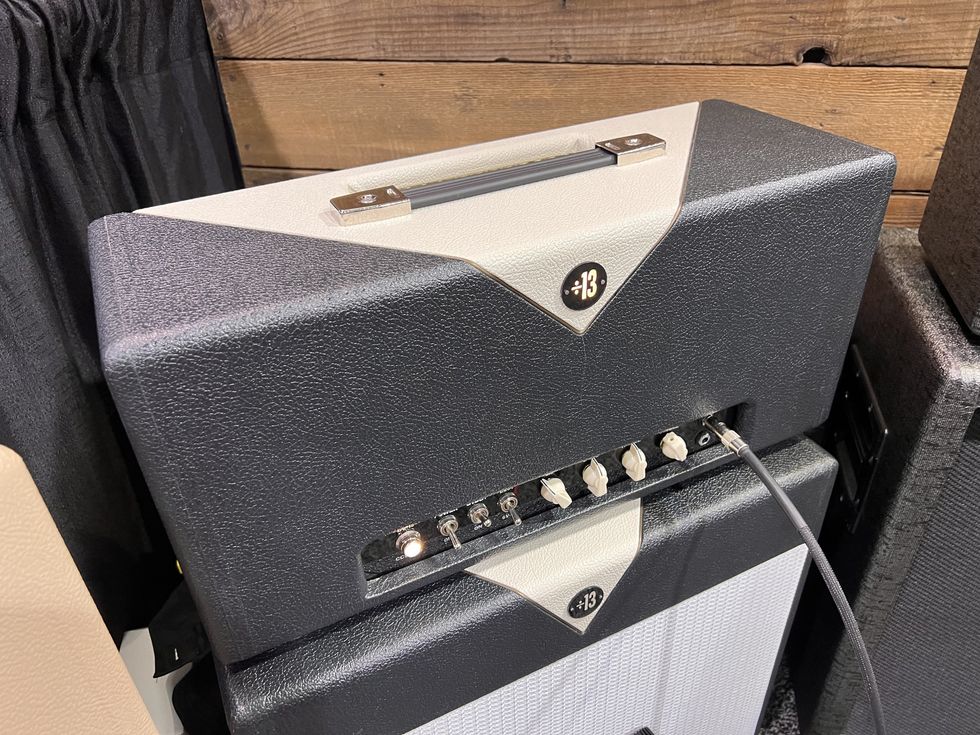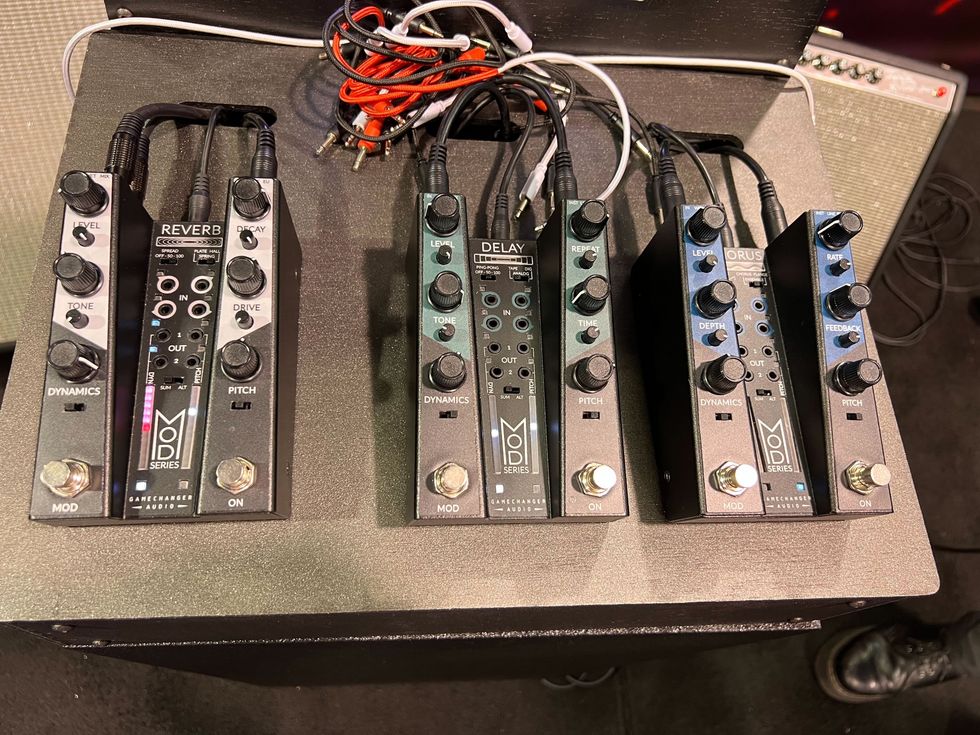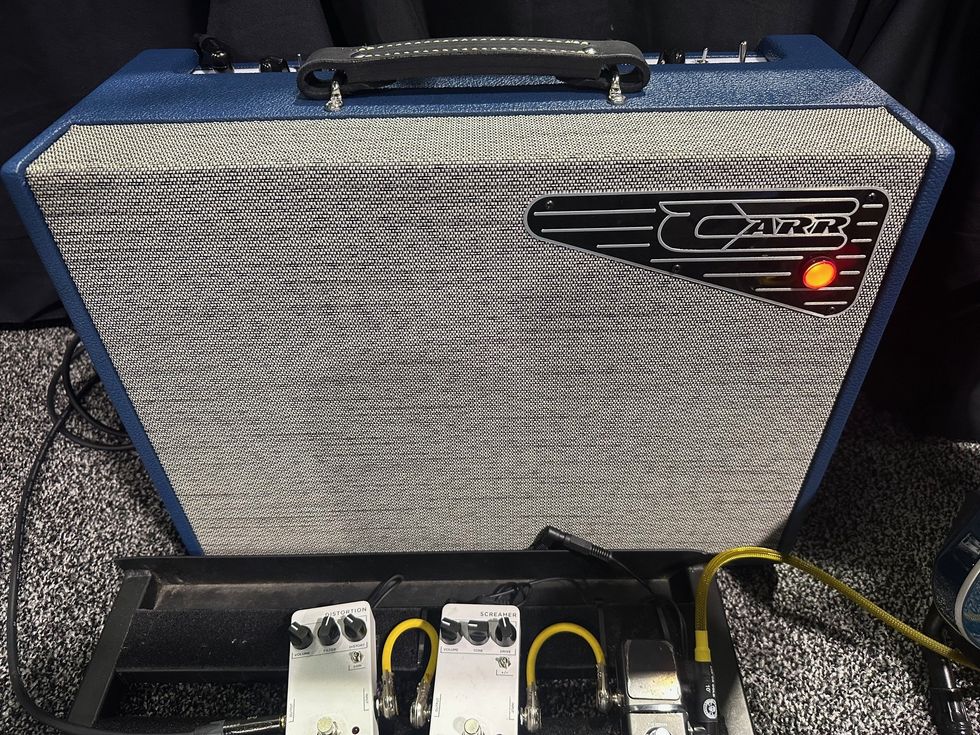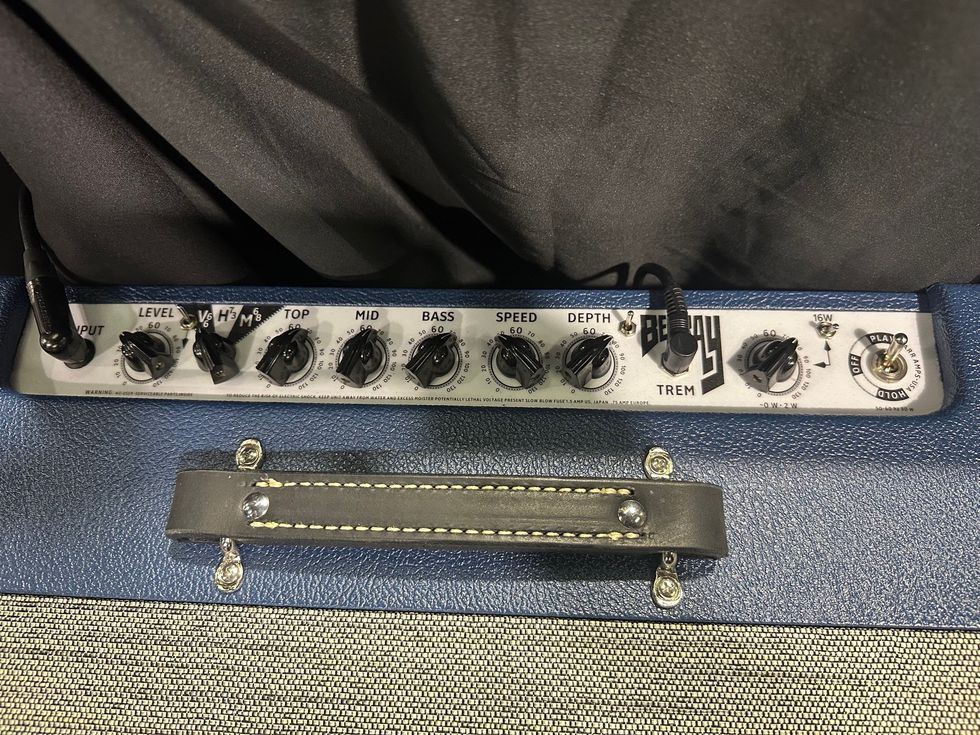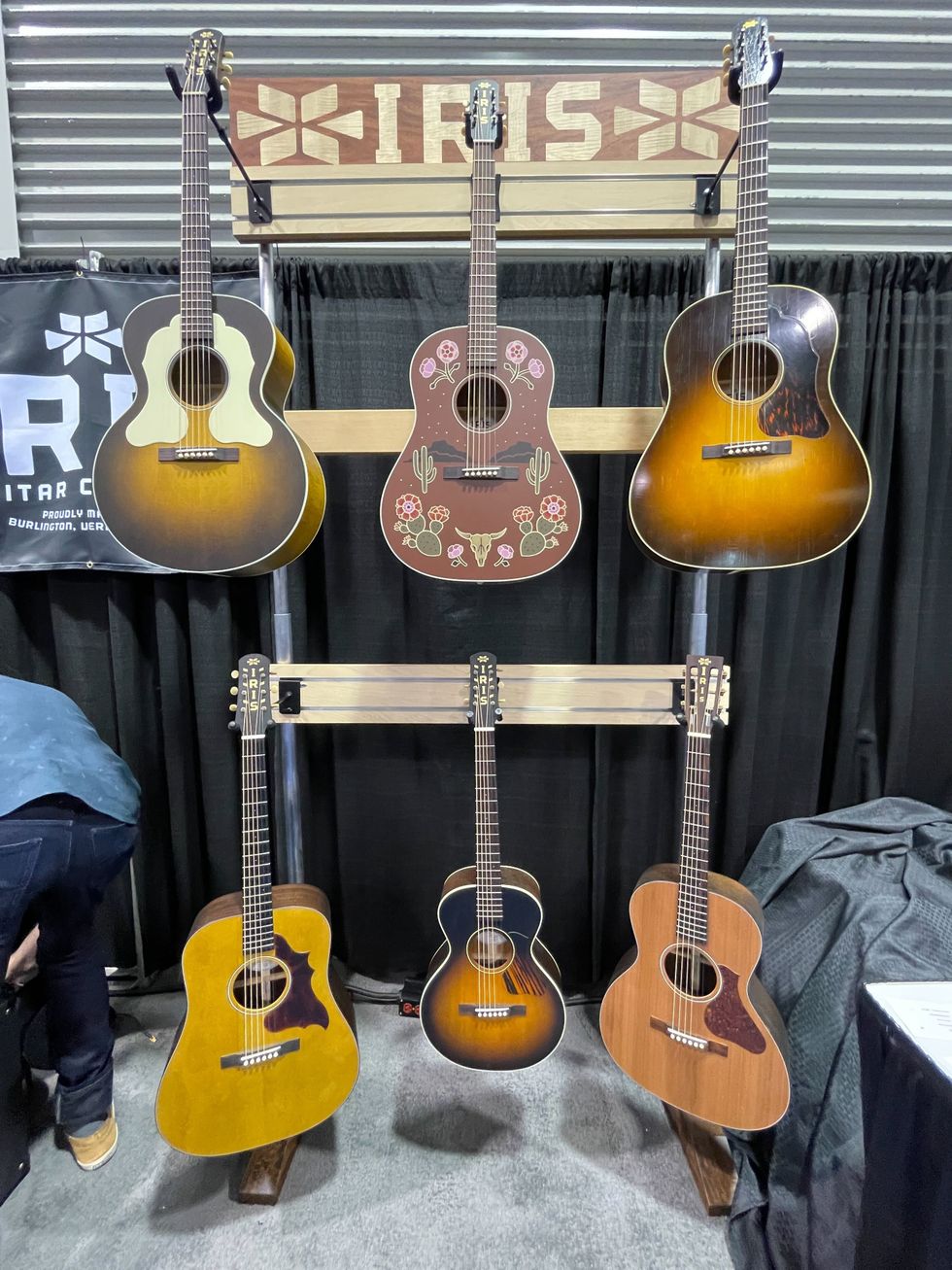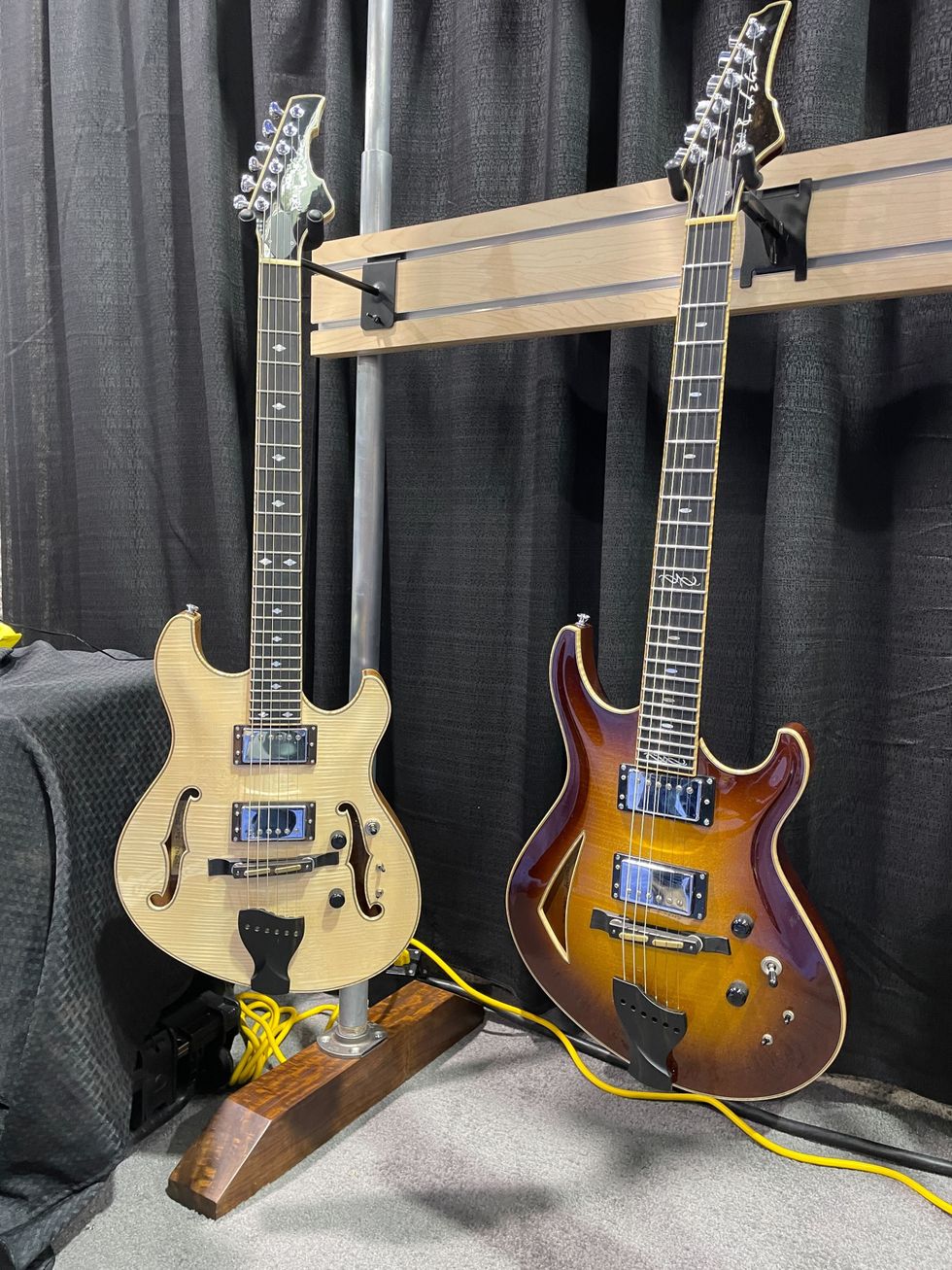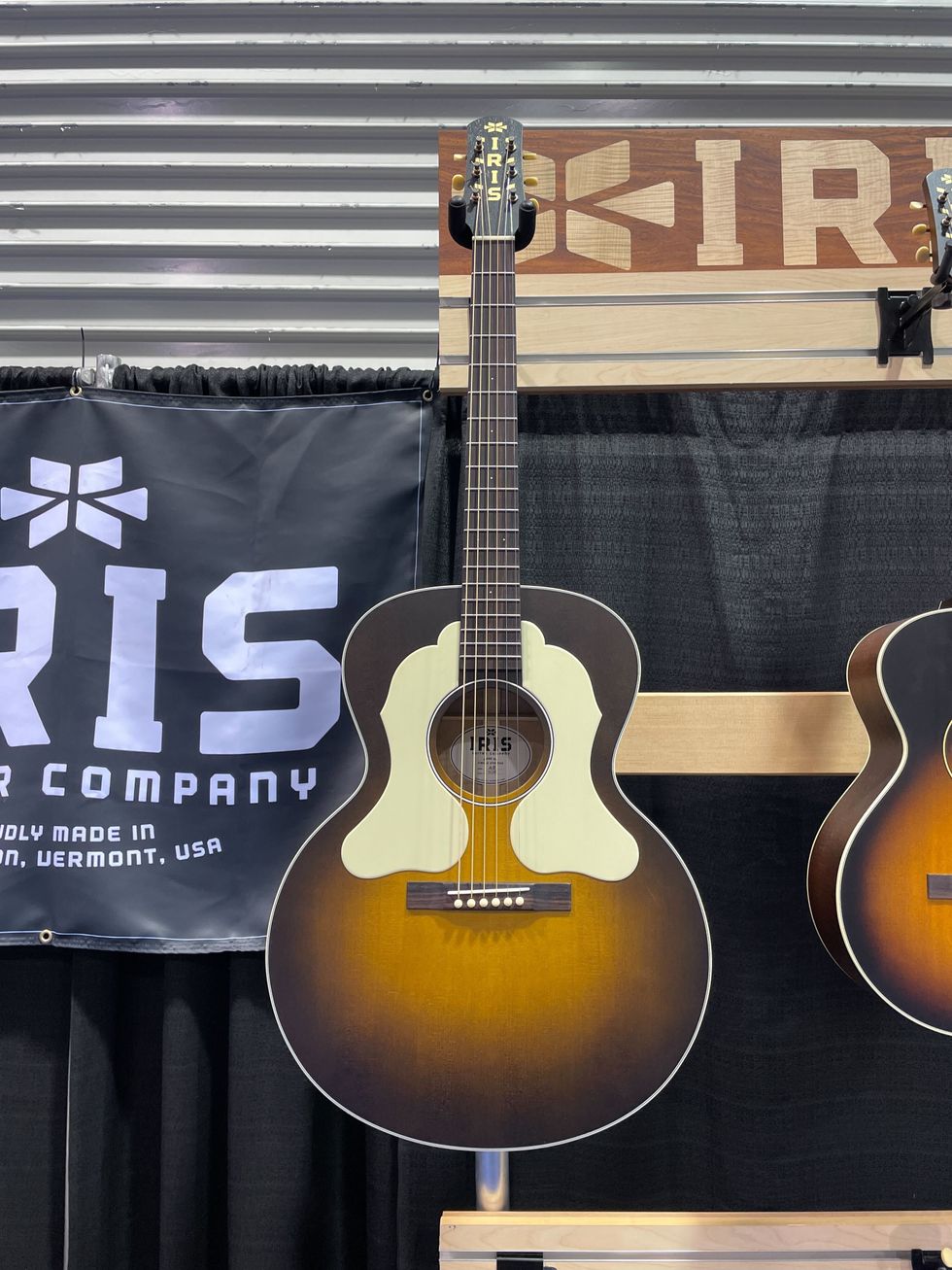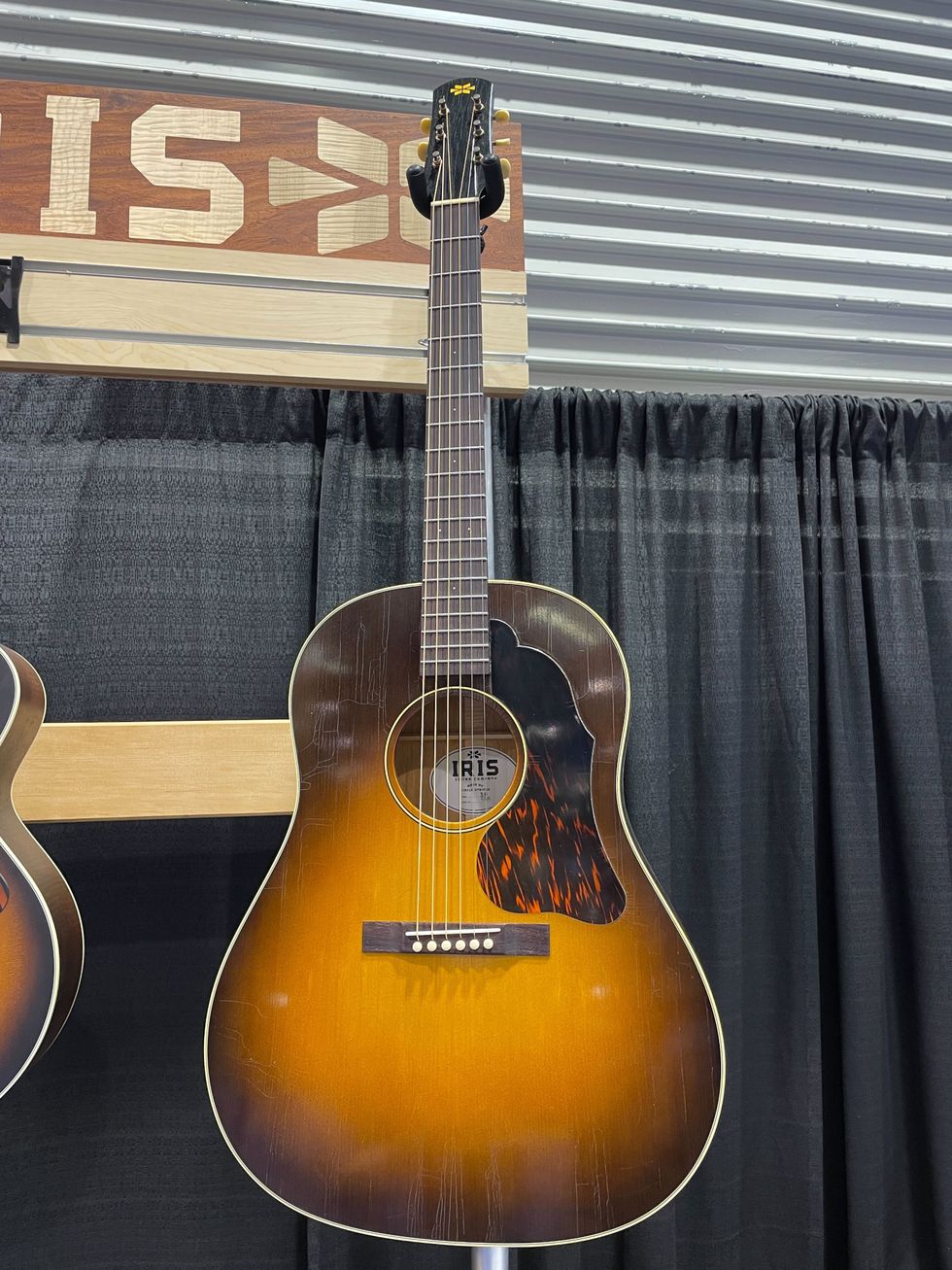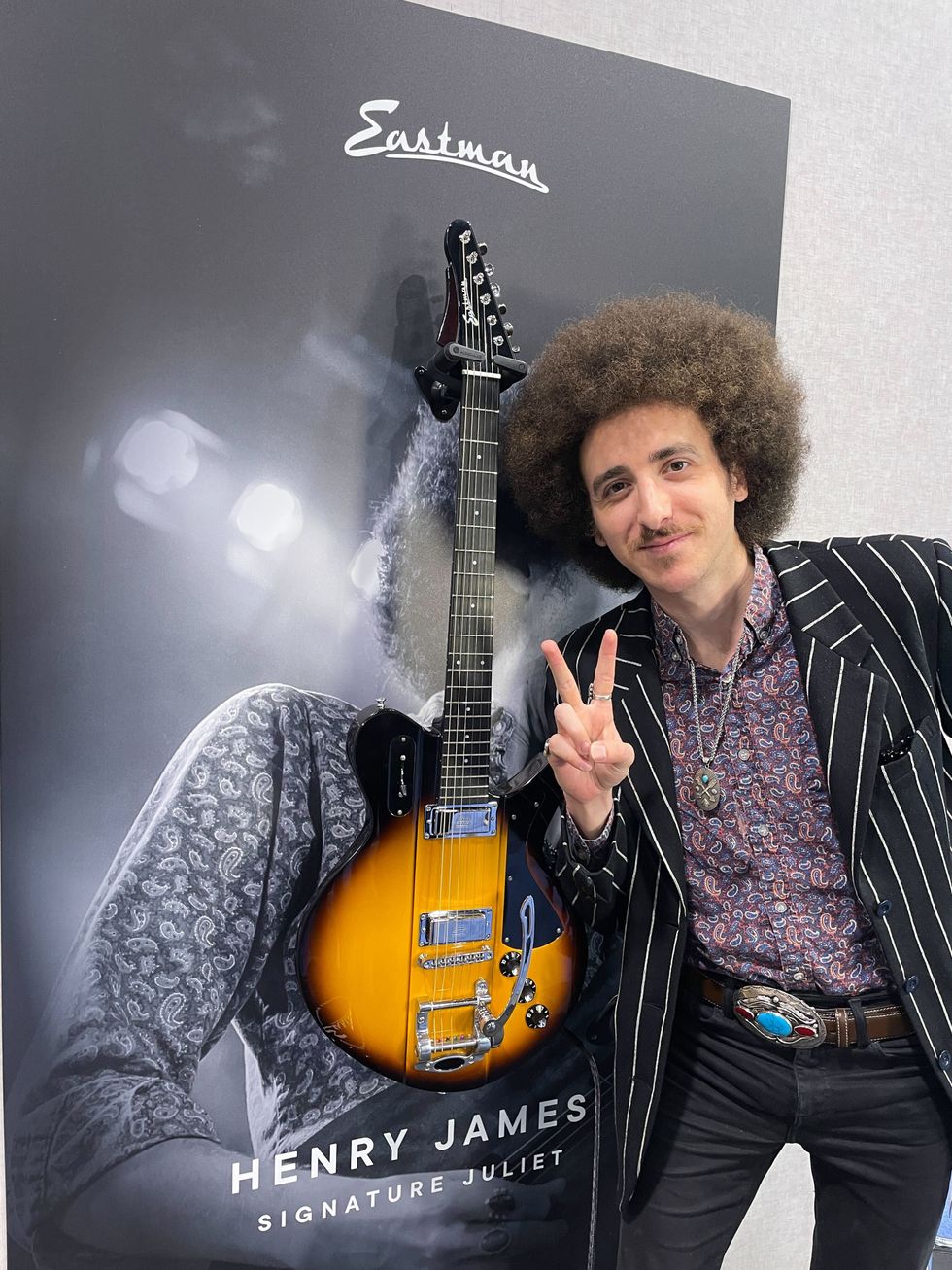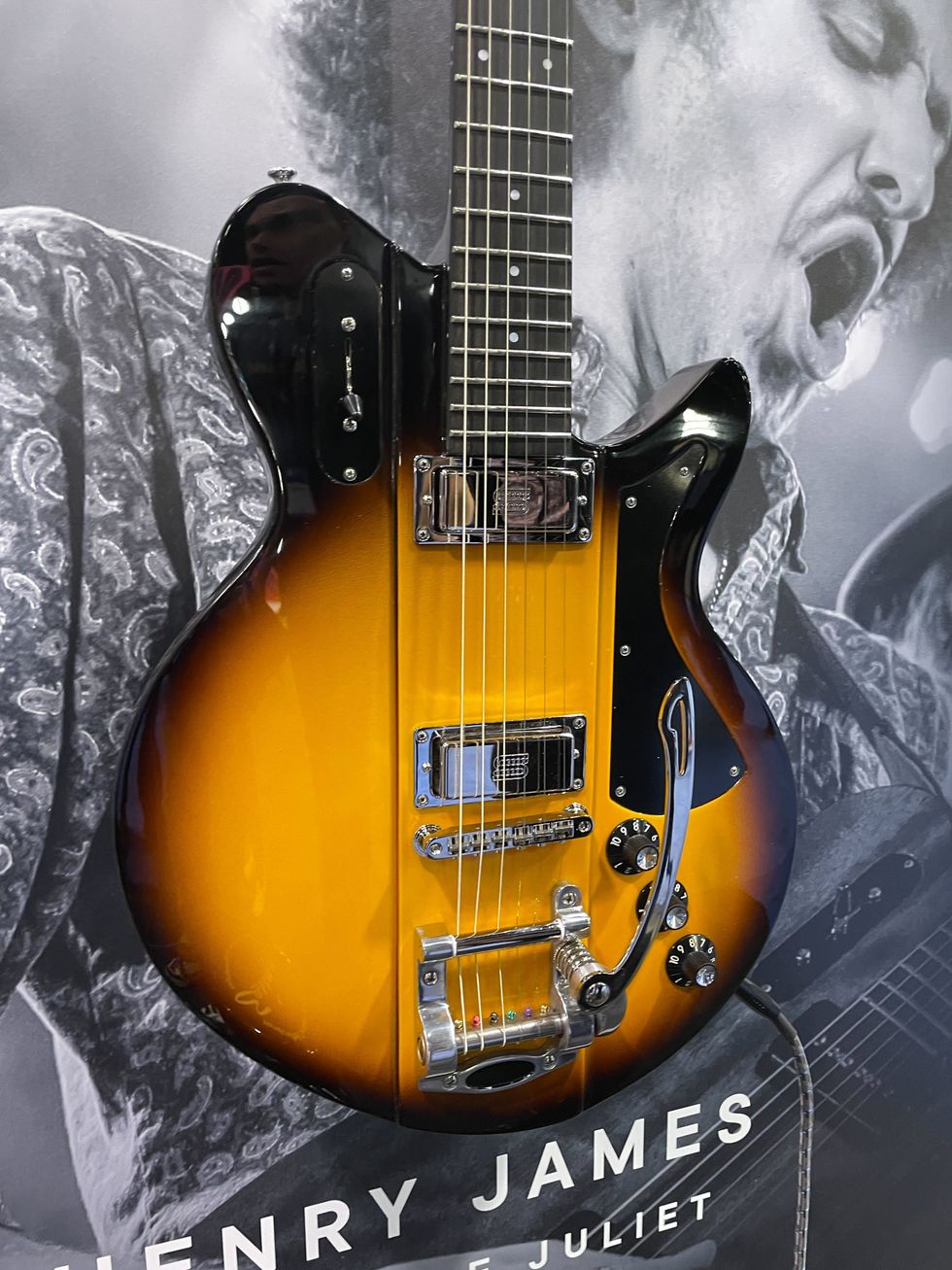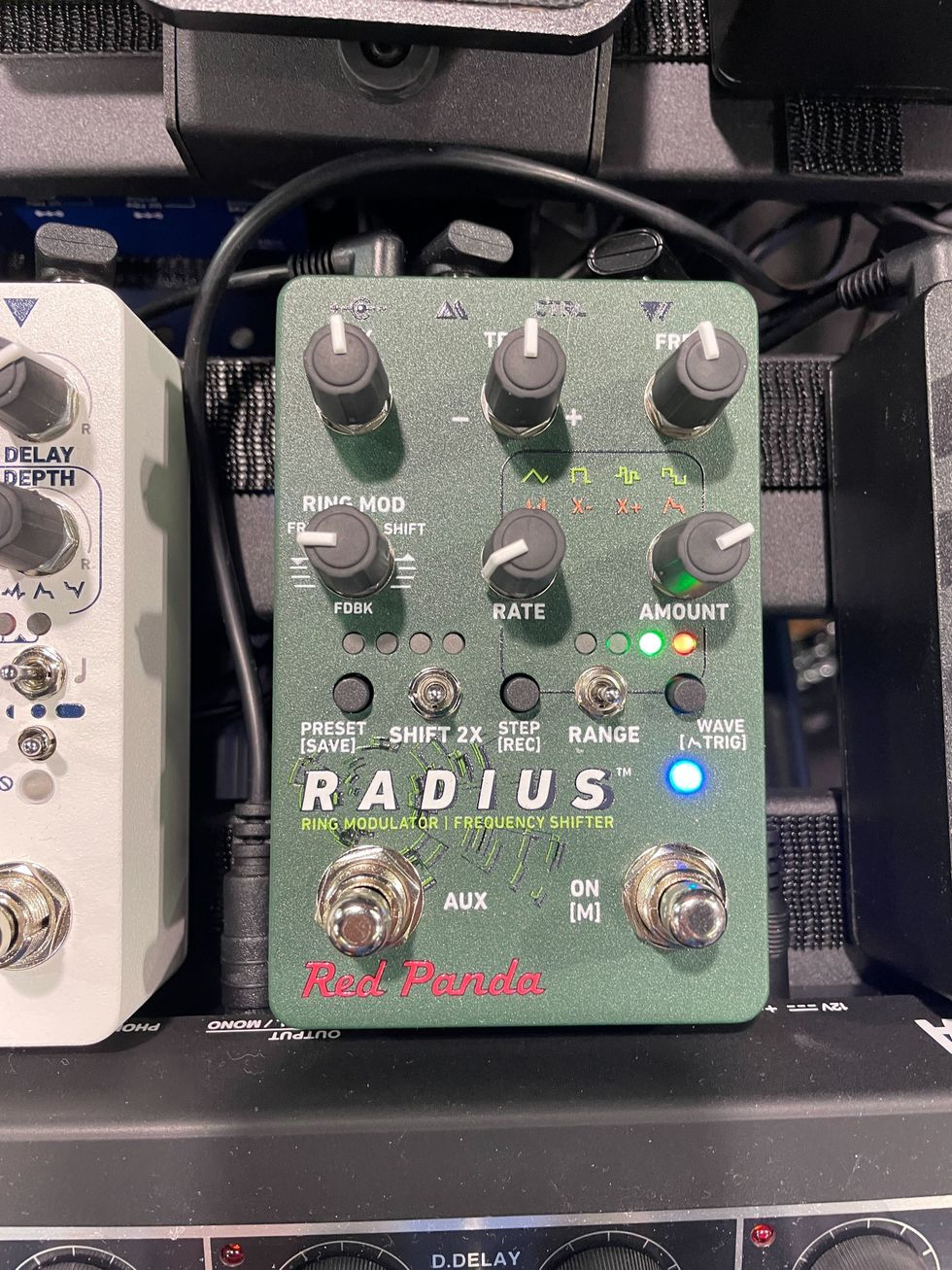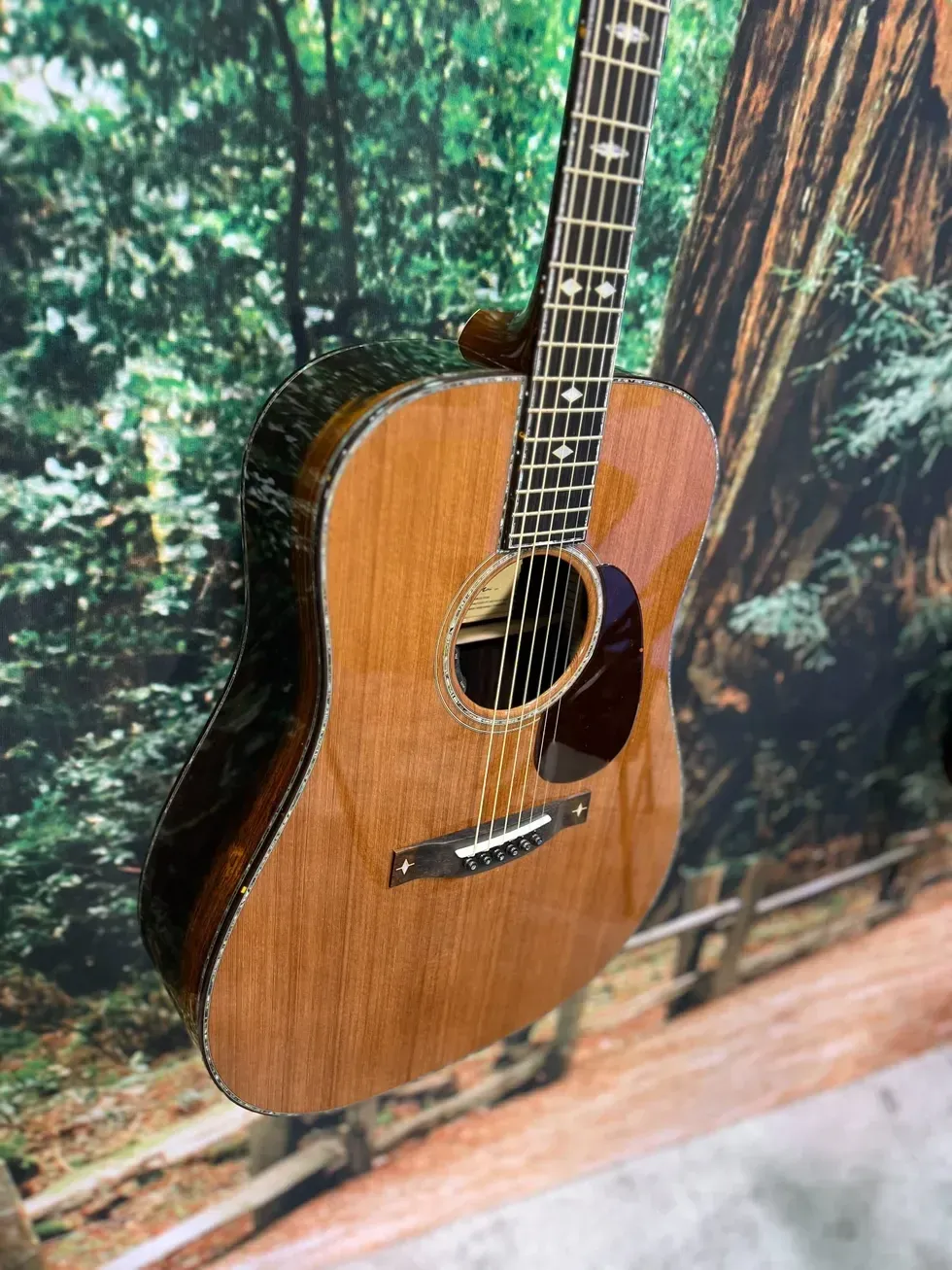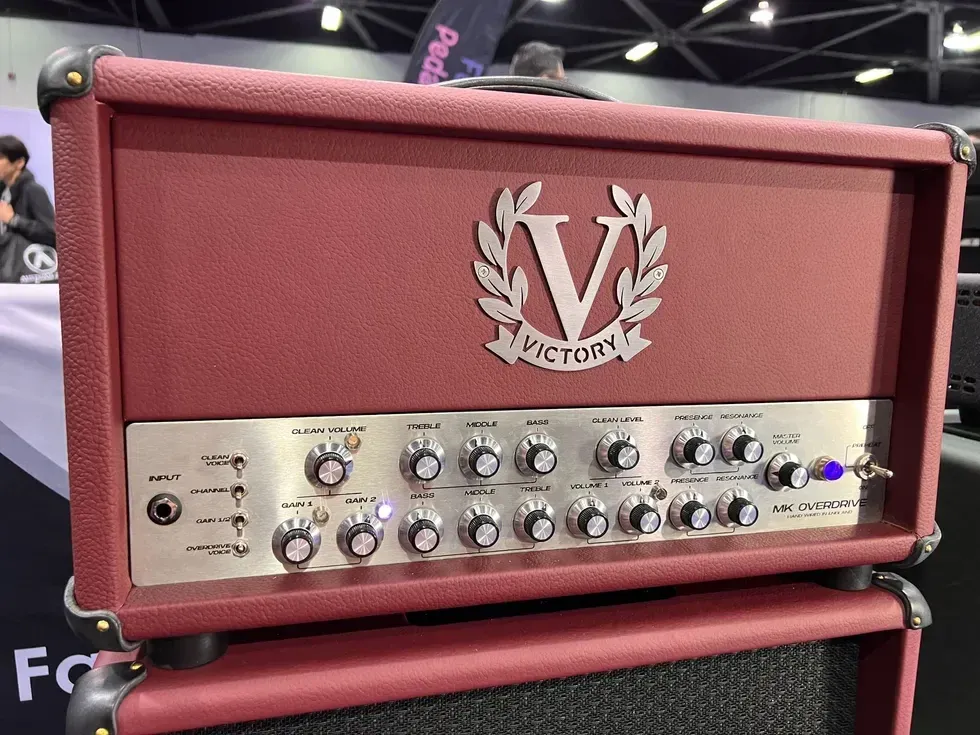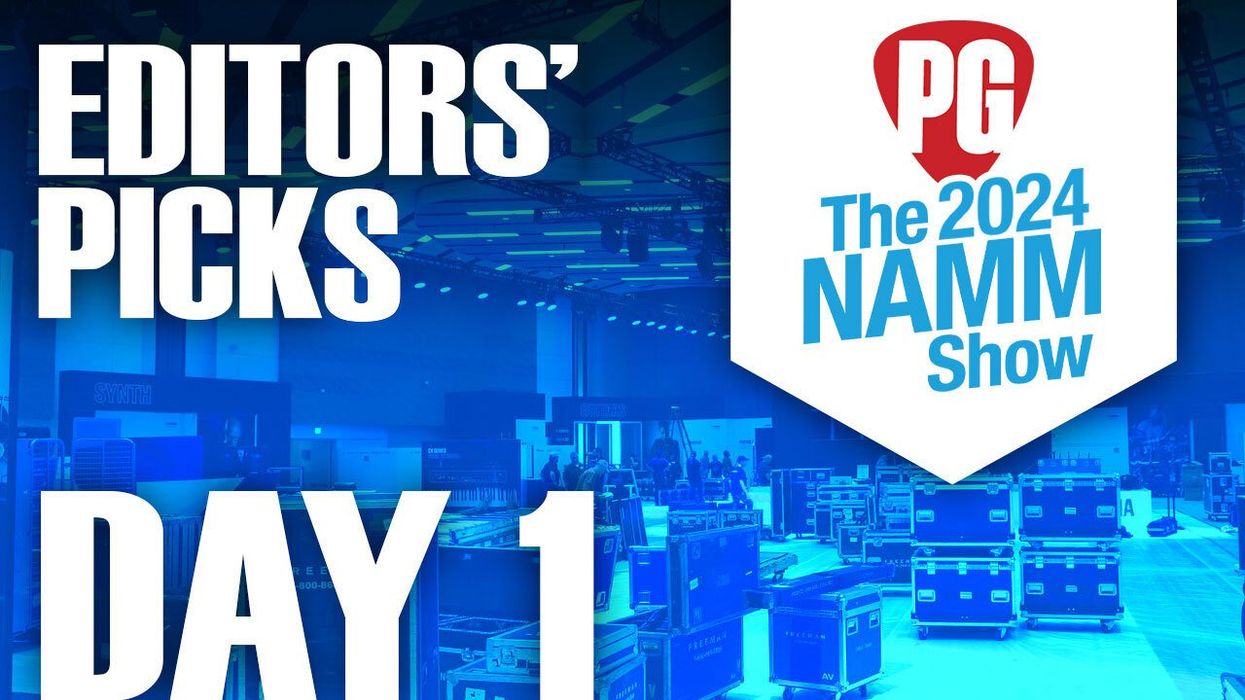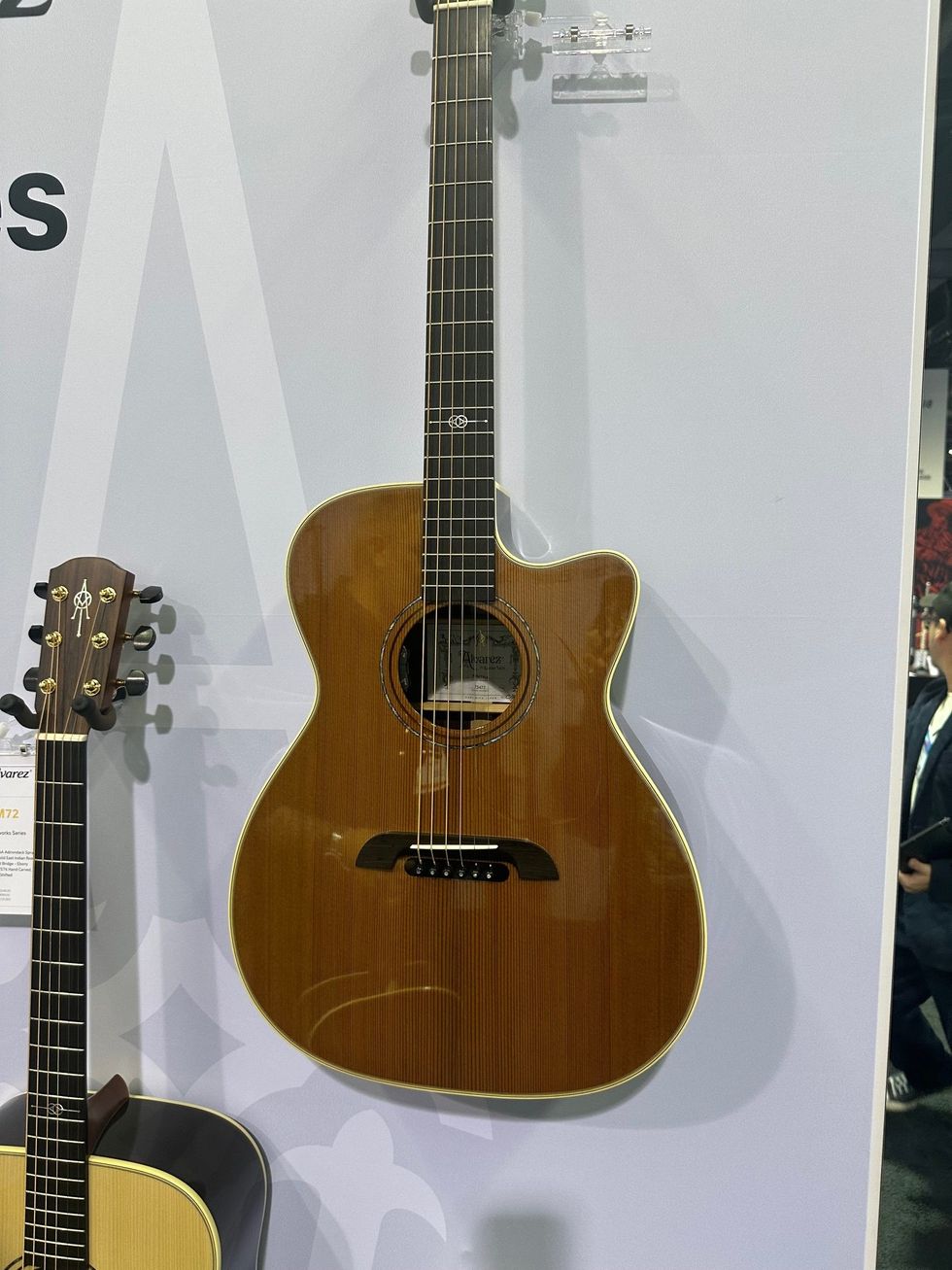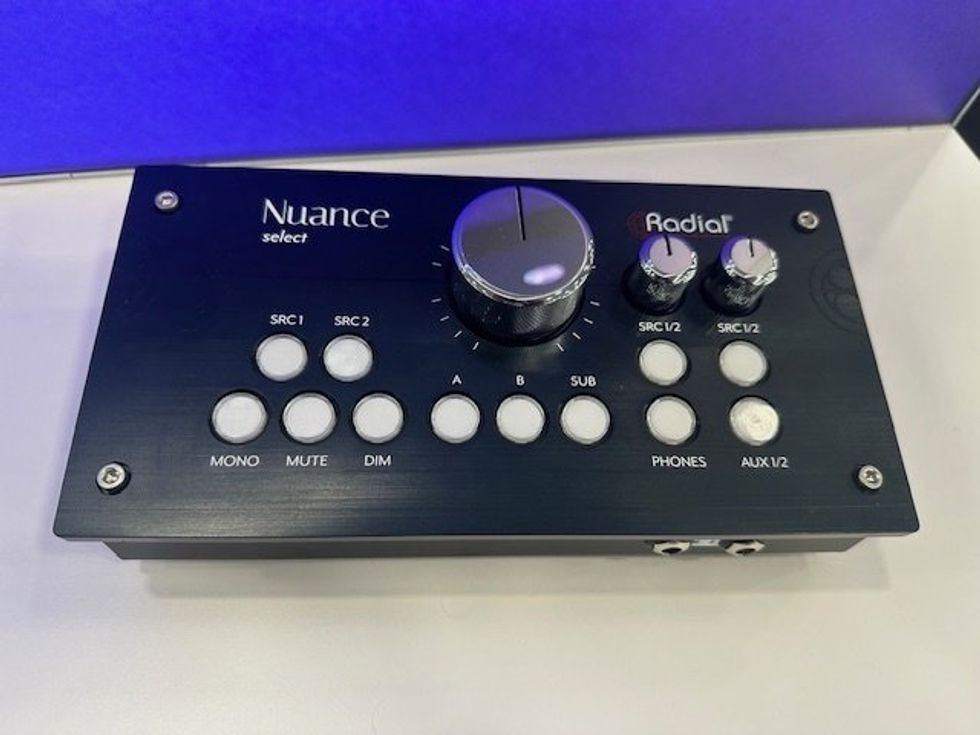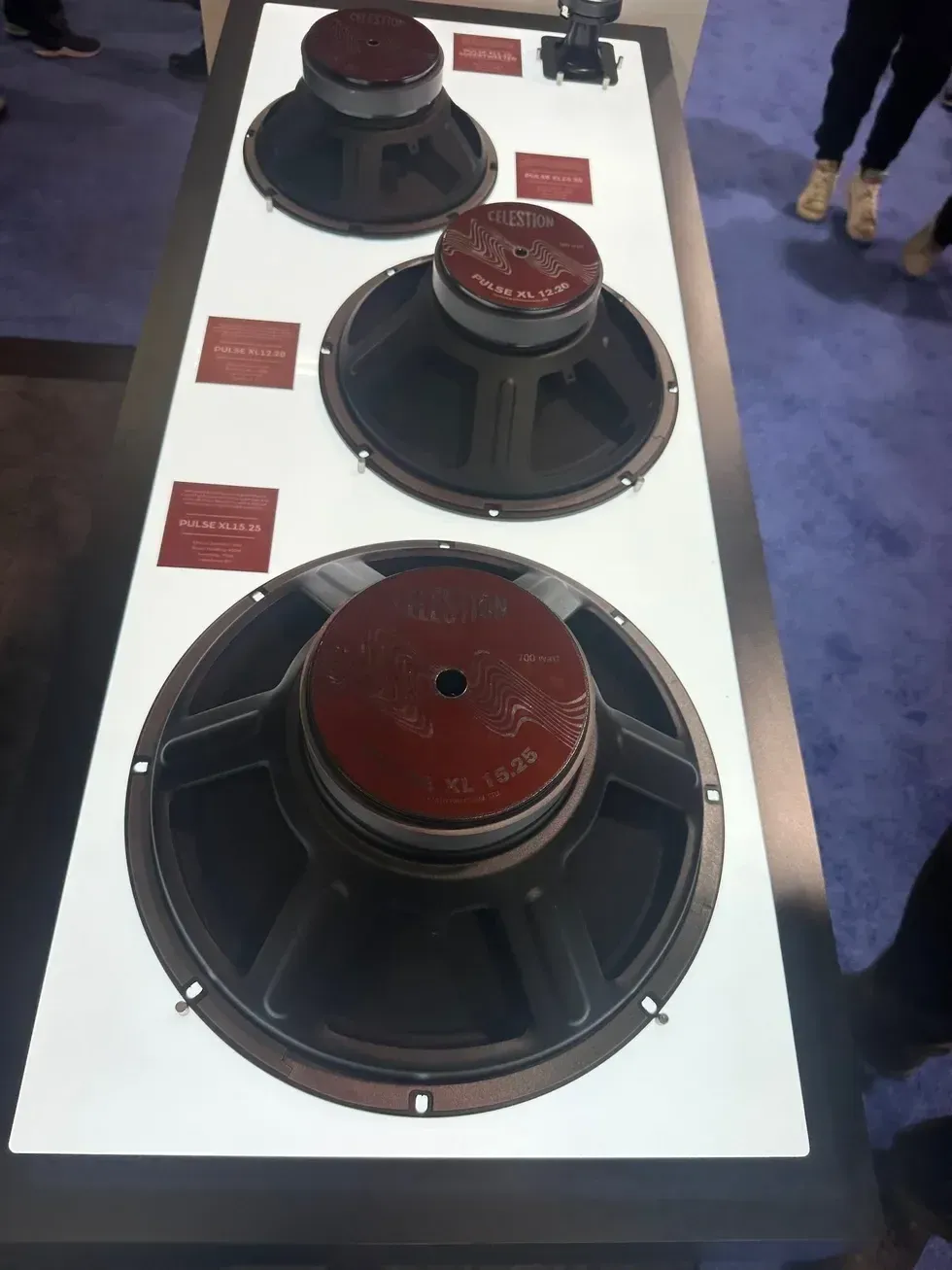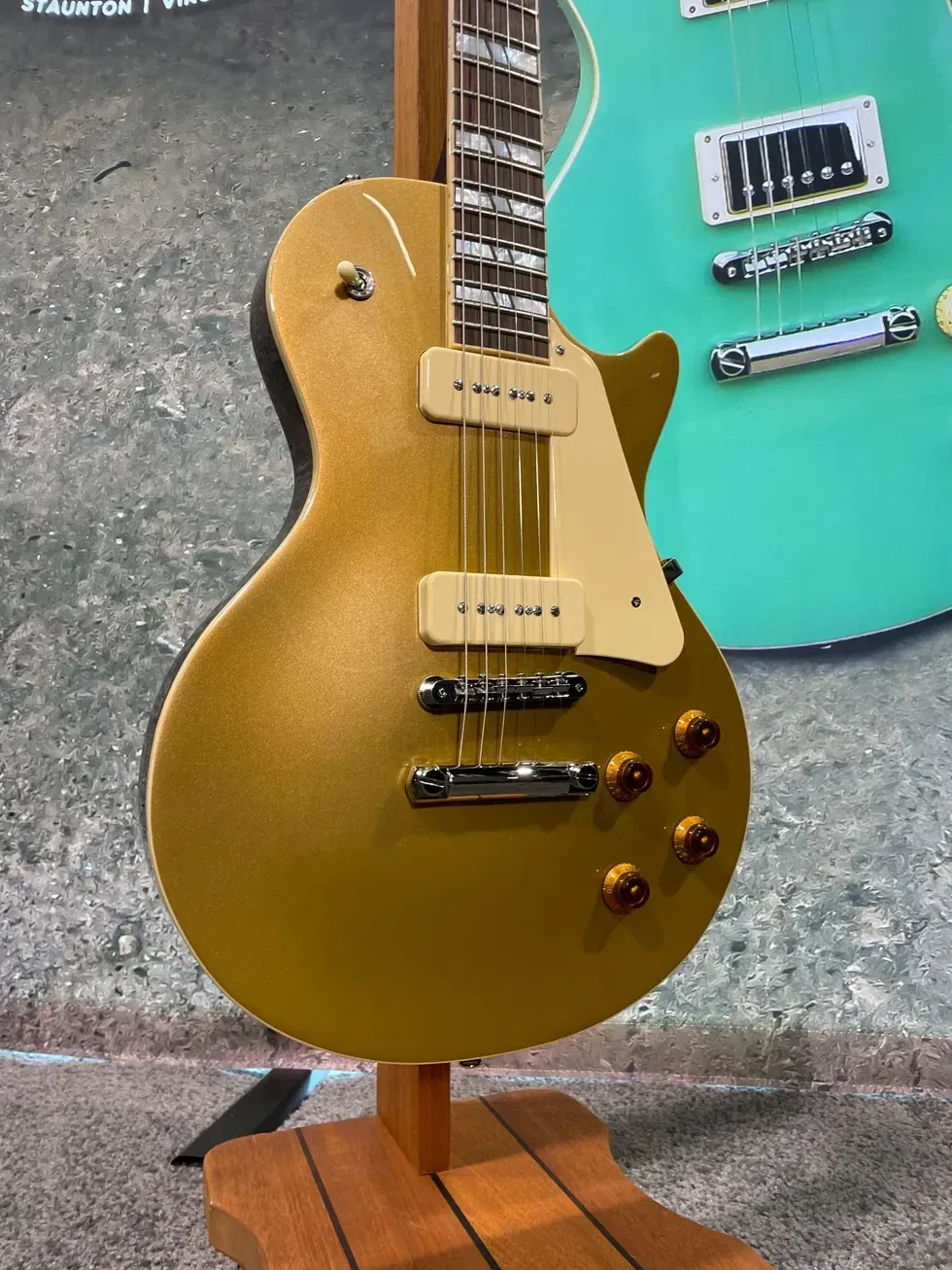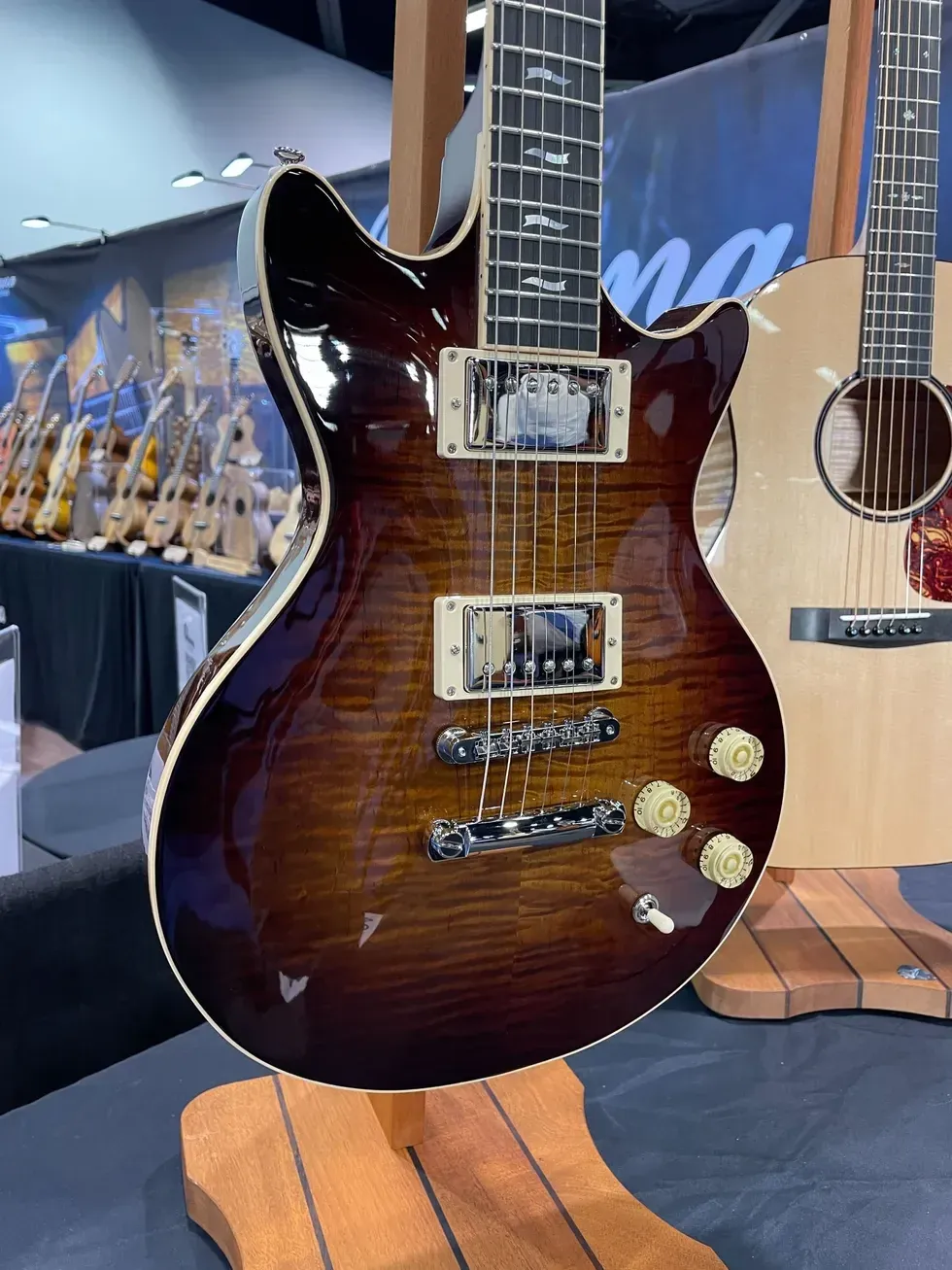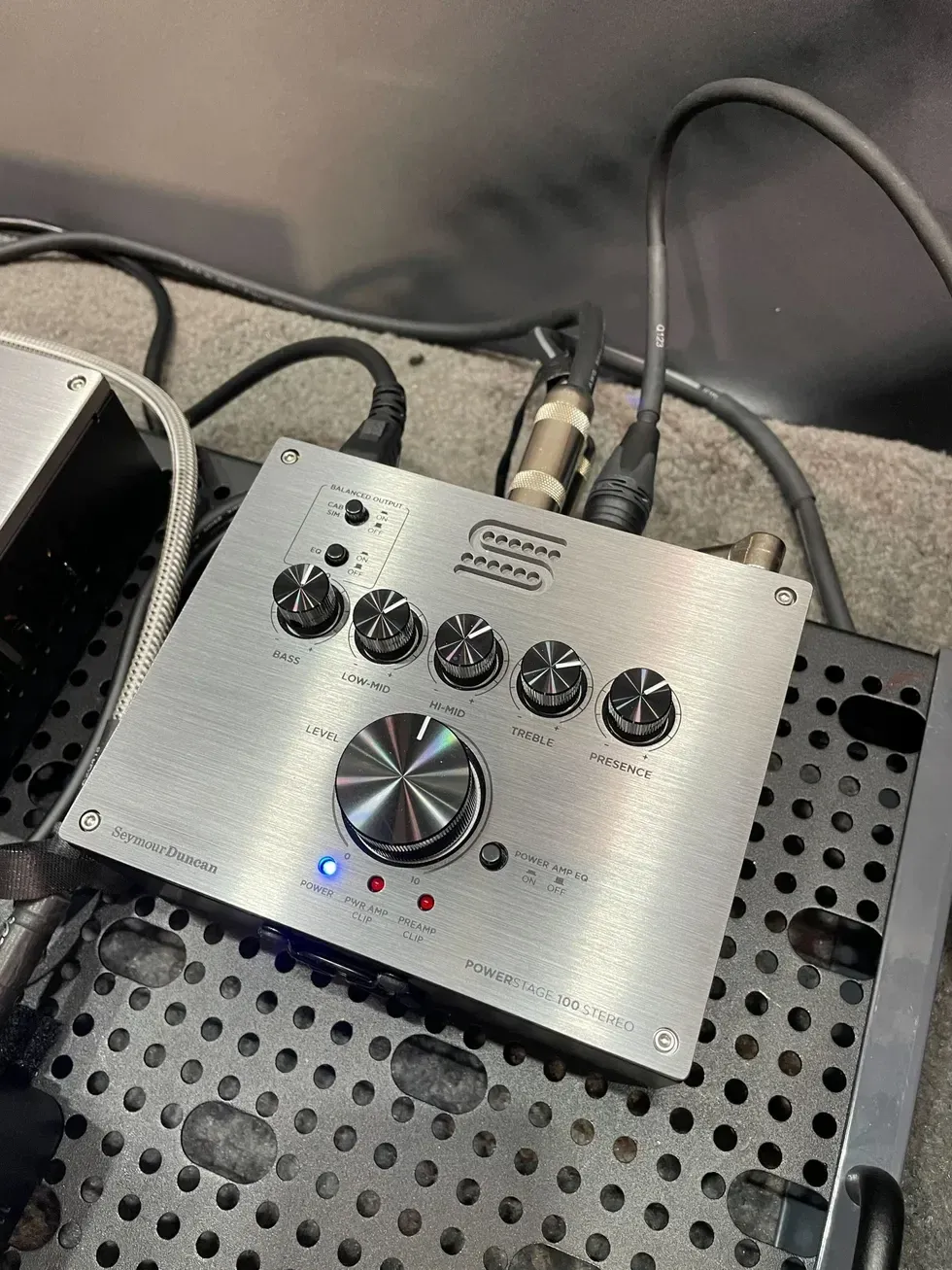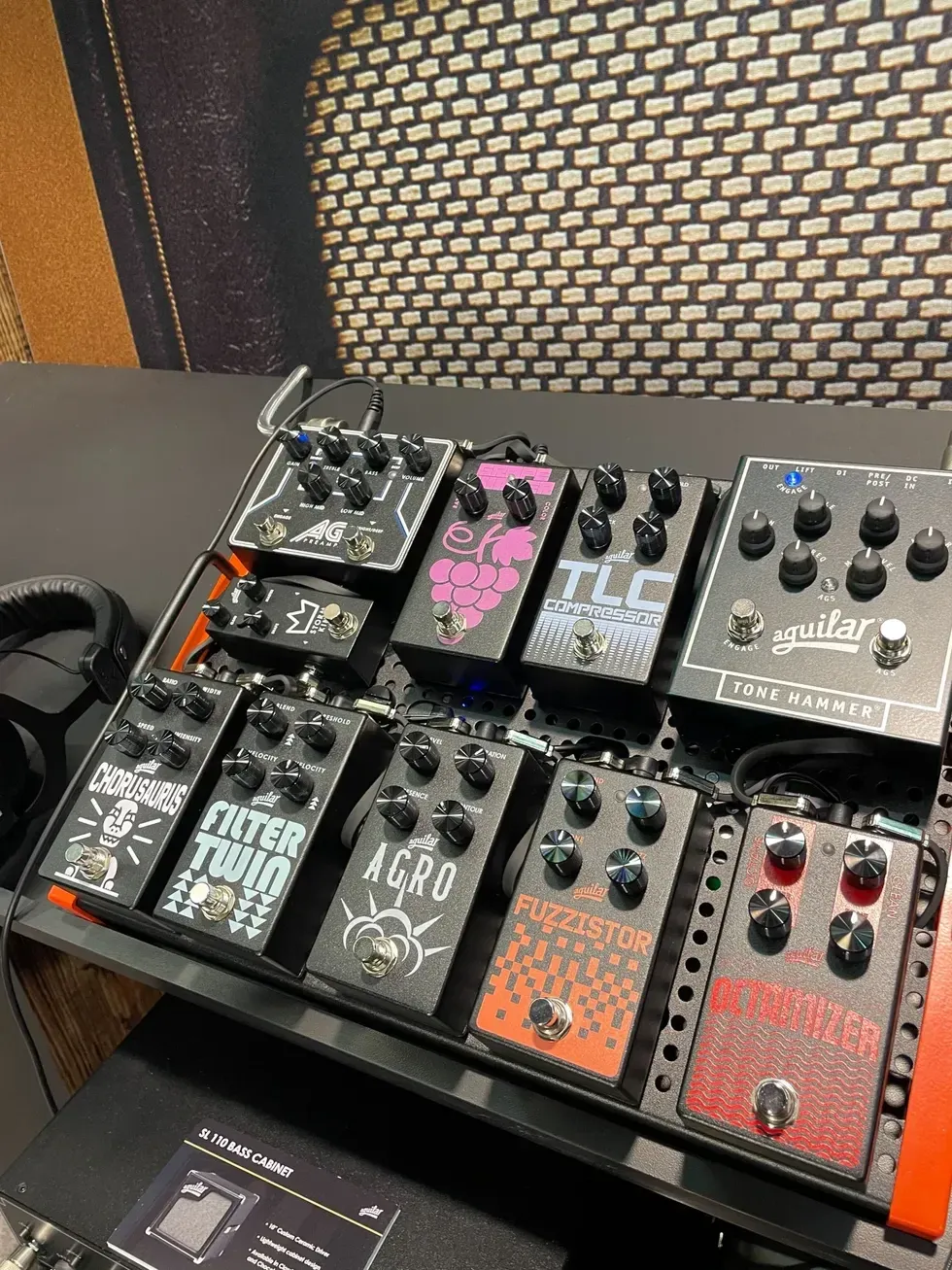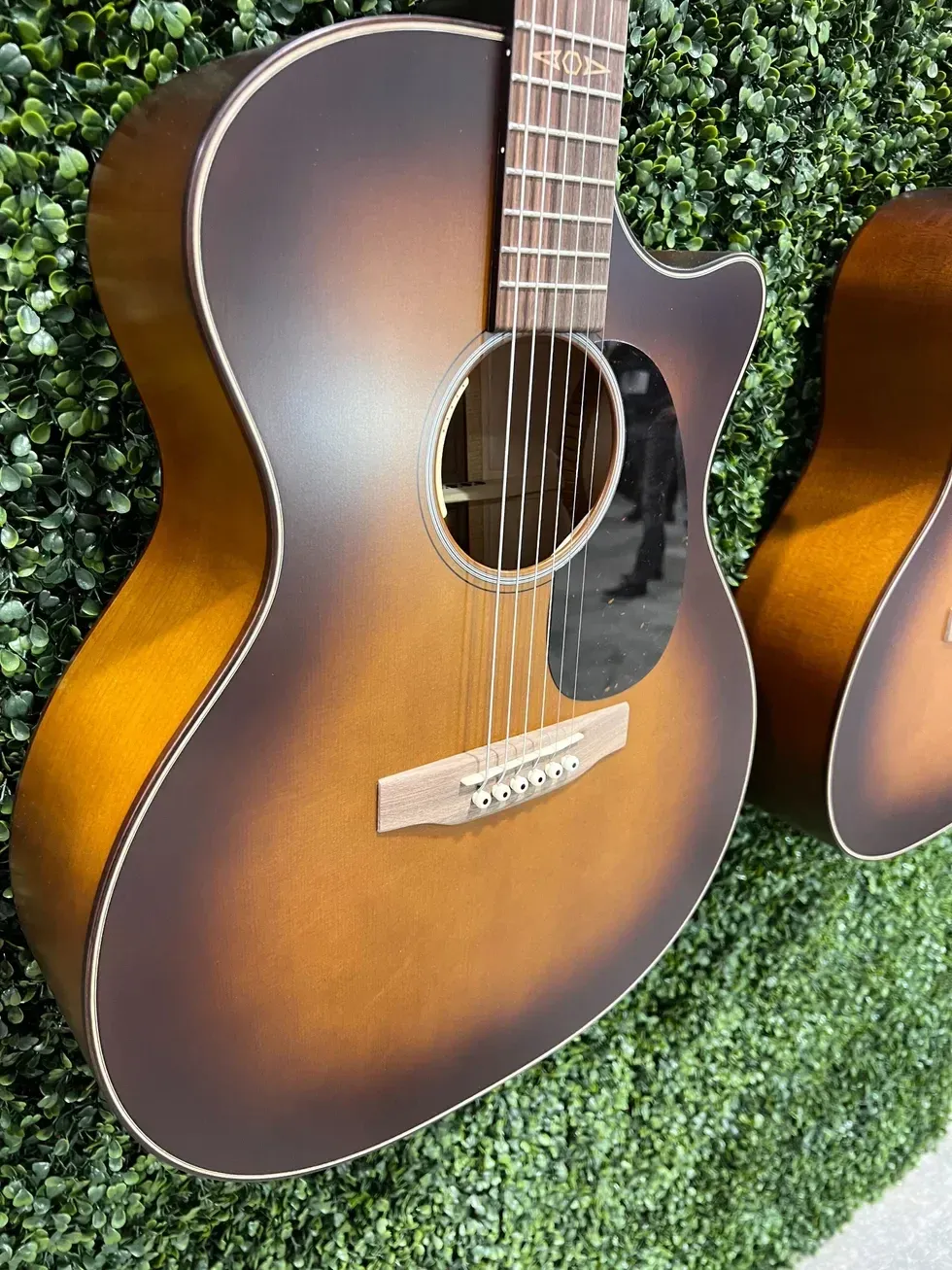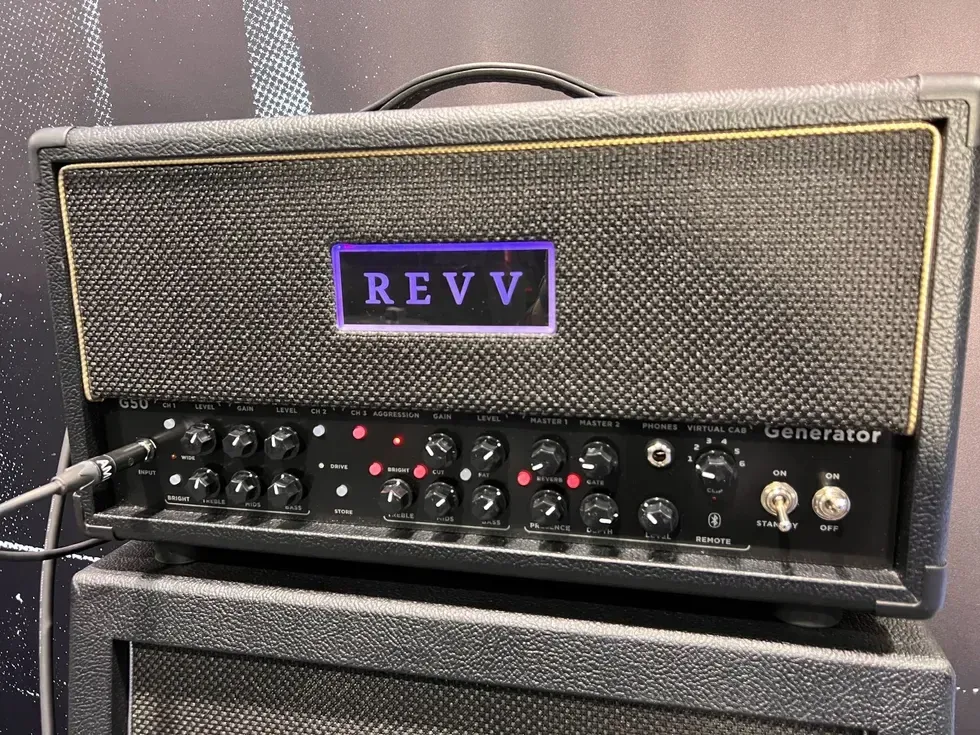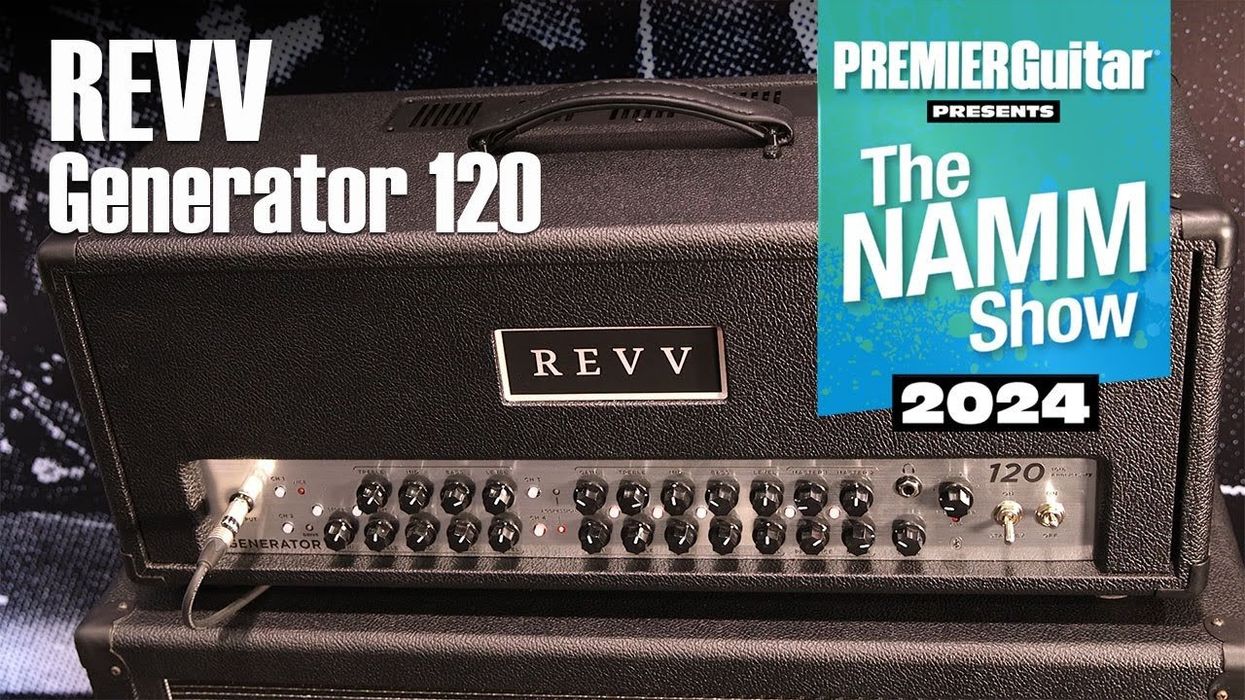Premier Guitar’s annual feature gives readers the chance to show off their pedalboards. There are so many ways of thinking when it comes to wiring up your effects—that’s the fun of it! In this round we’ve got a tribute to Eddie Van Halen, a pandemic board from Amsterdam, a maximalist stomper with 17 pedals, a curly cord “board,” and much more. Go forth to discover new pedals, and stomp on!
Aaron Costello: A Waylon Button
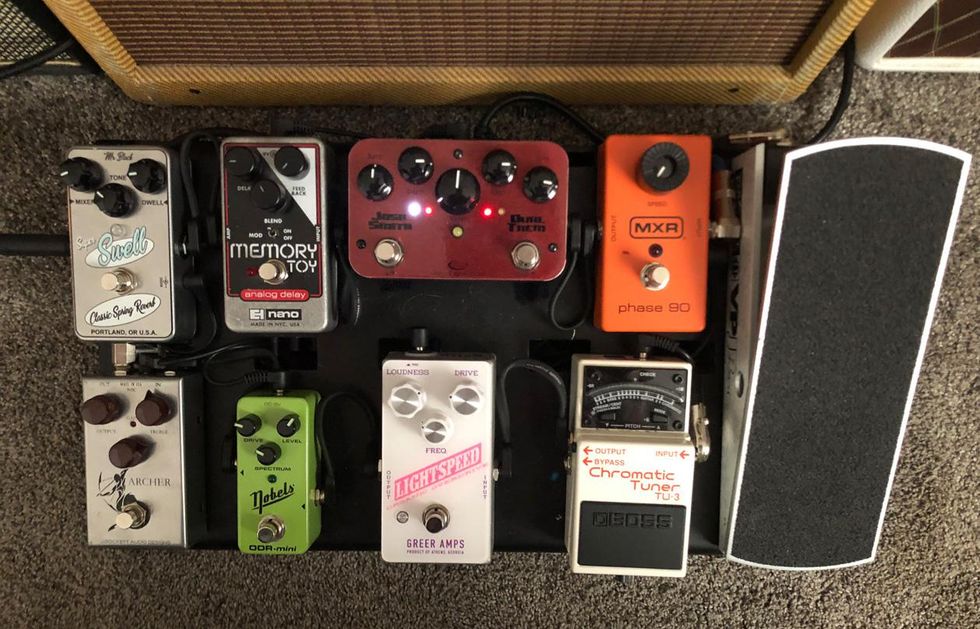
I live in Portland, Oregon. When I built this board, the goal was to get a clear, natural, amp-like sound, with multiple gain stages. Lots of trial and error (which was fun), and, after laboring over decisions that are of absolutely no consequence to productive society, here’s what I came up with.
1. Ernie Ball VP Jr.
Basic as it gets. I use it to quiet the rig when I play with acoustic instruments and am also trying to get the hang of pedal-steel bends. Still have some work to do there!
2. Boss TU-3
The standard.
3. Greer Amps Lightspeed
This thing is killer. With a single-coil guitar, I use it to push the Nobels ODR-Mini and get a little more gain without losing clarity. Typically, I use it for a raunchy rhythm sound. With a humbucker guitar, I usually shut the Nobels off and use it by itself.
4. Nobels ODR-Mini
This is my favorite pedal and the heart of the board. It’s very much like an amp. With a single-coil guitar, I use it for my clean sound and it’s always on. I really dig the edge-of-breakup thing.
5. J. Rockett Audio Archer
I like this behind the Nobels and use it to get a “singing,” higher-gain lead tone. Again, it retains the clarity at higher gain but still sounds like an amp.
6. MXR Phase 90
I literally call this the “Waylon Button.”
7. J. Rockett Audio Josh Smith Dual Trem
I don’t use it a ton but sometimes it’s the perfect thing to add color. Sometimes I’ll use it with the Greer and then fade it in and out with the volume pedal. It lets me mimic an organ pad and is kind of fun.
8. EHX Memory Toy Mini
This is my second favorite pedal. I use it for a slapback sound and it’s almost always on.
9. Mr. Black Super Swell Reverb
My main amps are a 1975 Princeton Reverb and a 1978 Vibrolux Reverb, so I usually like the amp reverb. I do have a couple of amps in my home studio that don’t have reverb, so I use this with those. It also sounds great on bass!
10. Voodoo Labs Pedal Power 4x4
This is under the board and does the job. Thanks for reading!
Bert Harris: My Curly “Board”
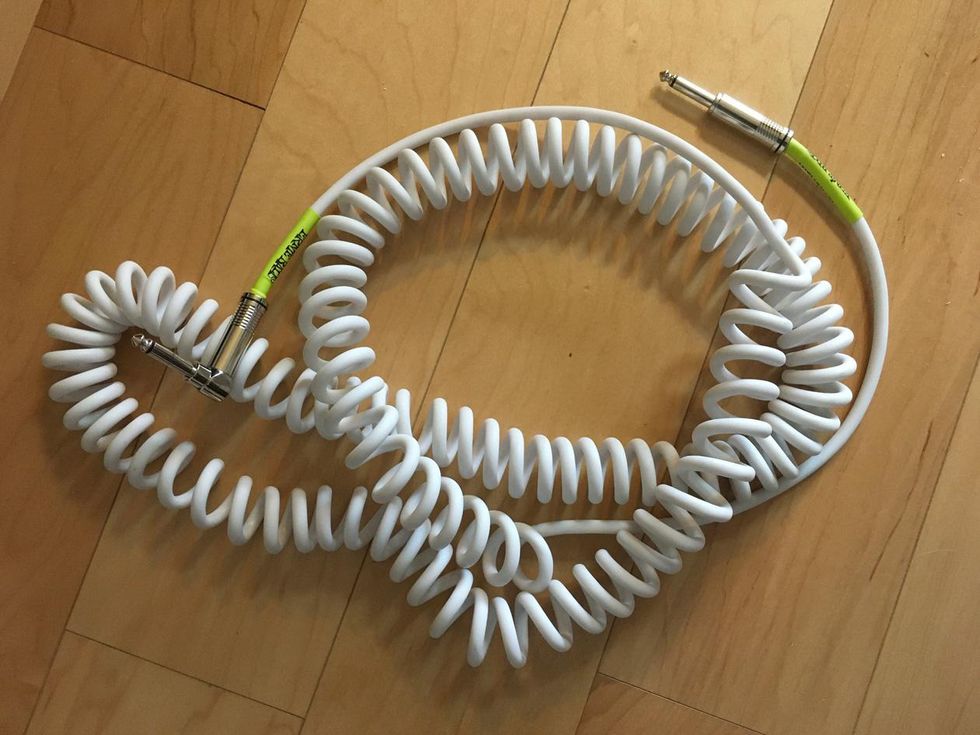
Here’s my pedalboard … I prefer to plug straight in and get all my tone from the amp itself. Nothing cooler than Clapton with a white curly cord plugged directly into a Fender Dual Showman at The Rolling Stones Rock and Roll Circus! I love the thought of showing up with a guitar, amp, pick, and curly cord!
Admittedly, I’m kinda lazy and plugging in a bunch of stuff is a beating to me … although I have been using an Xotic EP Booster lately, but it’s battery powered. Hope your day is a wonderful one!
Brian Schwager: Short and Sweet
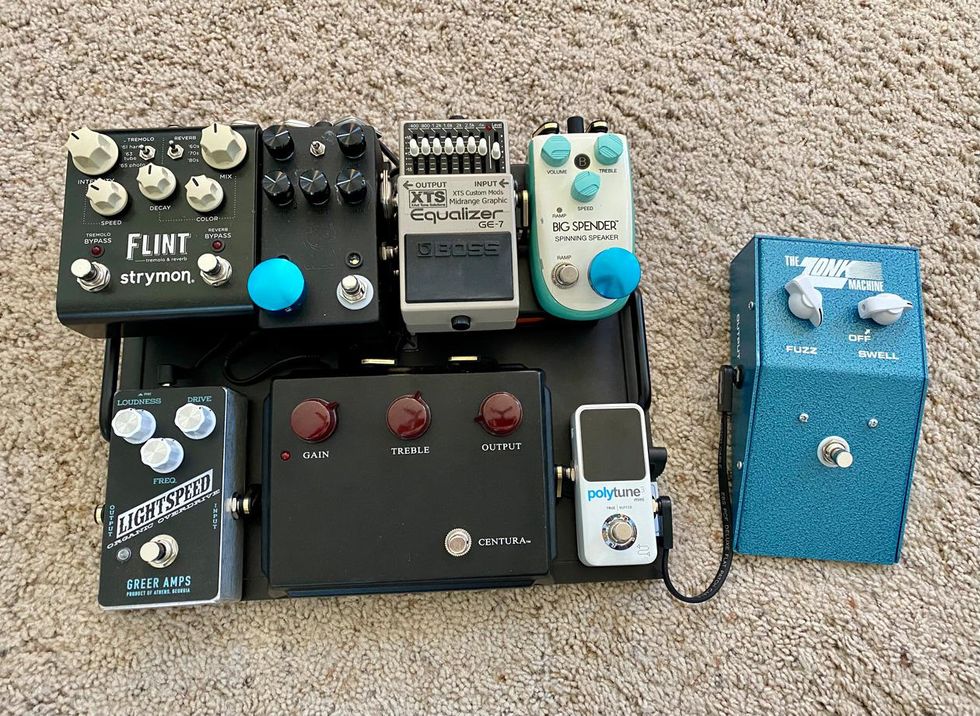
Hello, I play in multiple bands in Des Moines, Iowa. Here’s what I got goin’ on my pedalboard:
- British Pedal Company Zonk Machine
- TC Electronic PolyTune 3 Mini
- Ceriatone Centura
- Greer Amps Lightspeed
- Danelectro Billionaire Big Spender Spinning Speaker
- Boss (XTS Custom Mods) GE-7 Equalizer
- JHS Pedals Lucky Cat Delay
- Strymon Flint
- Lehle P-Split (under the raiser, top right)
Drew Smith: Three is the Magic Number
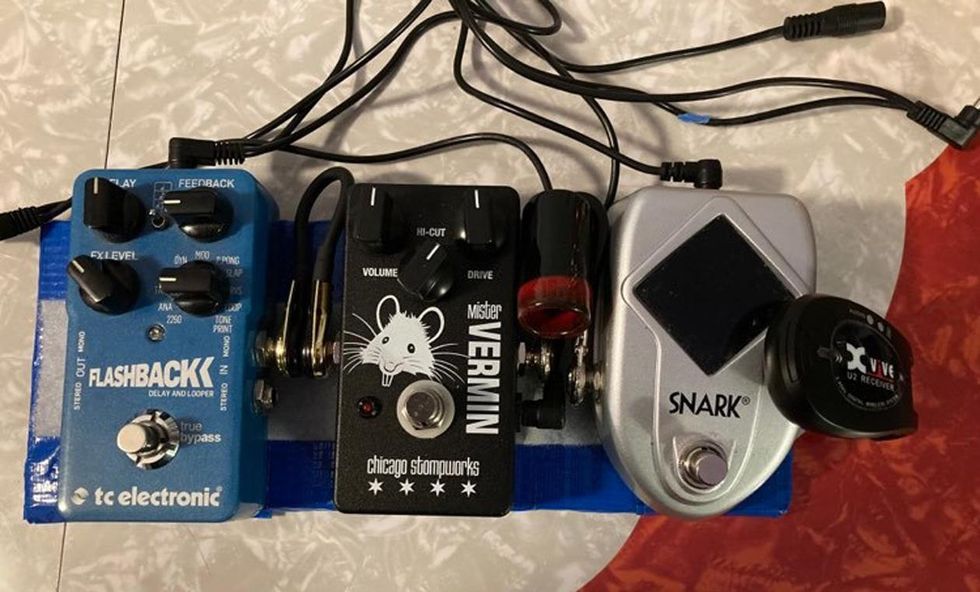
I love these reader pedalboards: I hope you feature my board! I’m in a psychedelic punk-blues duo called Phantom Ocean, based out of New England. We’re heavily indebted to alternative music from the ’80s, ’90s, and early 2000s, and because there’s only two of us, my wife on drums and me on guitar, I keep my rig pretty tight. I need a few solid guitar tones and tend not to dip into too much modulation. To that end, my board right now only has three pedals: tuner, dirt, and delay.
For a tuner, I’ve got a Snark because it’s economical and does the job right. For dirt, I’ve got a Chicago Stompworks Mr. Vermin, their version of a Pro Co RAT, and it’s the best RAT I’ve ever tried. The first time I plugged into this thing, I finally understood why the RAT is so beloved by so many guitarists whose ears I respect. It really covers such a broad swathe of tones, from overdrive to straight-up fuzz. And then the TC Electronic Flashback is my favorite delay. I’ve never had one fail on me, you can get such a variety of sounds, and the TonePrint feature is always there to craft something really wild.
I round the board out with an XVive U2 wireless system, because I hate accidentally dragging cables across my board and freedom of movement onstage is a joy (even if I spend half the set near the mic anyway). I also use one of (Premier Guitar Senior Editor) Ted Drozdowski’s Rocky Mountain signature slides for my slide-guitar work.
Ernie Santella: Does-It-All Board
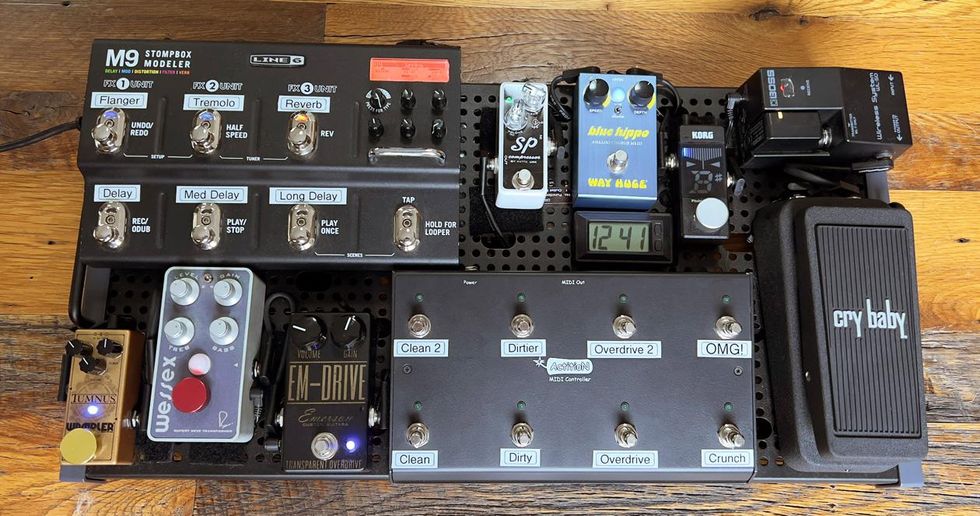
I built this pedalboard for my classic-rock cover band Wasted on the Young, out in Colorado. We cover everything from Bonnie Raitt to Stevie Ray Vaughan to ZZ Top to Maroon 5. So, I had to have a pedalboard that would fit just about anything our band needed to play. I think I achieved that. I have it all right underfoot at all times. I’m old-school and wanted to stay analog for the input side and then just a little digital on the effects loop side to keep the size down and give me the most bang for the space. I used a few mini pedals, but only if they sounded as good as their larger brethren.
I run my guitars (Heritage H-150, RS Guitarworks T-Style and S-Style, PRS Custom 24) with a single wireless. The Boss WL-50 is nice and clear-sounding with long battery life. Best part is, it auto-mutes when you unplug it, allowing for faster, noiseless guitar swaps.
The board is a Temple Duo 24, which is a great size and not too gnarly to carry. The wireless goes into the Dunlop Cry Baby Junior Wah (a classic-sounding wah with a slightly smaller size), then into the Korg Pitchblack, which is a nice and bright LED tuner, even outdoors. The tuner feeds the Xotic SP Compressor for some clean spank when needed. Next are three pedals for different levels of boost. Depending on the amp setting, the three boosts work differently. The Emerson EM-Drive is great for a quick Marshall-in-a-Box crunch tone. The Bogner Wessex is my over-the-top overdrive that has a nice compression to it. Lastly, the Wampler Tumnus is a Klon killer and is great for adding clean lead boost to anything, just by adding level and not too much gain.
I run that into a Hughes & Kettner GrandMeister 36 head. The amp is all analog, but digitally controlled by MIDI. So, technically, you have 128 amp presets. I use a cheap ActitioN 8-button MIDI controller I found on Reverb for amp presets. From spanky clean to OMG gain. It’s like having an 8-channel amp! I can just step through 8 levels of gain in increments.
The effects loop of the amp feeds the Way Huge Smalls Blue Hippo set to the Joe Bonamassa-approved chorus setting that gives a killer rotary-speaker tone. Then, into the Line 6 M9 for chorus, tremolo, flange, and spring reverb for the many different tunes we play. Lastly, the clock for keeping us on schedule during a gig. We’ve been known to jam out and forget the set schedule! Hope you like it!
Fernando Diaz: Clean, Mean Maximalist

Greetings! Here is the current iteration of my pedalboard. It’s powered by a Strymon Zuma, and two Strymon Ojai expansion kits.
The chain is as follows:- Dunlop 535Q Cry Baby Multi-Wah
- Basic Audio Scarab Deluxe
- King Tone Octaland Mini
- Spaceman Sputnik III
- TC Electronic PolyTune 3 Mini
- Paul Cochrane Timmy
- Ibanez TS9 Tube Screamer (with Alchemy Audio mod)
- Browne Amplification Protein
- Barber Electronics Gain Changer SR
- Hudson Electronics Broadcast
- Land Devices HP-2
- Greer Amps Supa Cobra
- Keeley Katana Boost
- Walrus Audio Julia V1
- Dreadbox Komorebi
- JHS Pedals Panther Cub V2
- Neunaber Immerse Reverberator Mk II
Jelle Veirman: Booze Protected
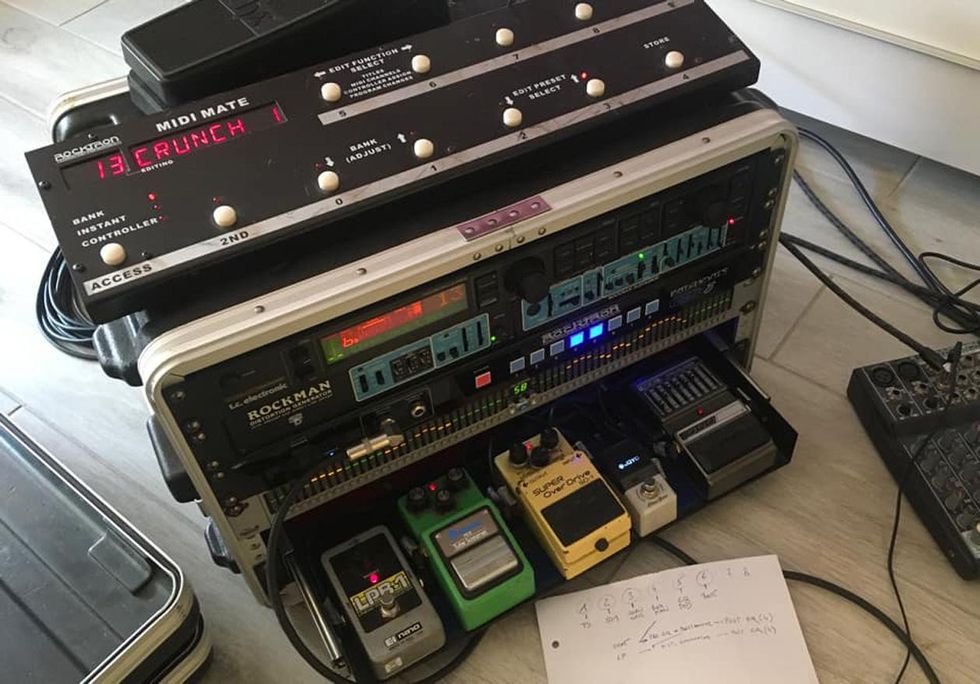
This is the gear I use almost daily, playing a wide range of genres in different cover bands, from classic rock to contemporary music. I had to figure out a way to get the most out of my Stratocaster and Les Paul through one compact system and protect my gear against drunk people and their booze.
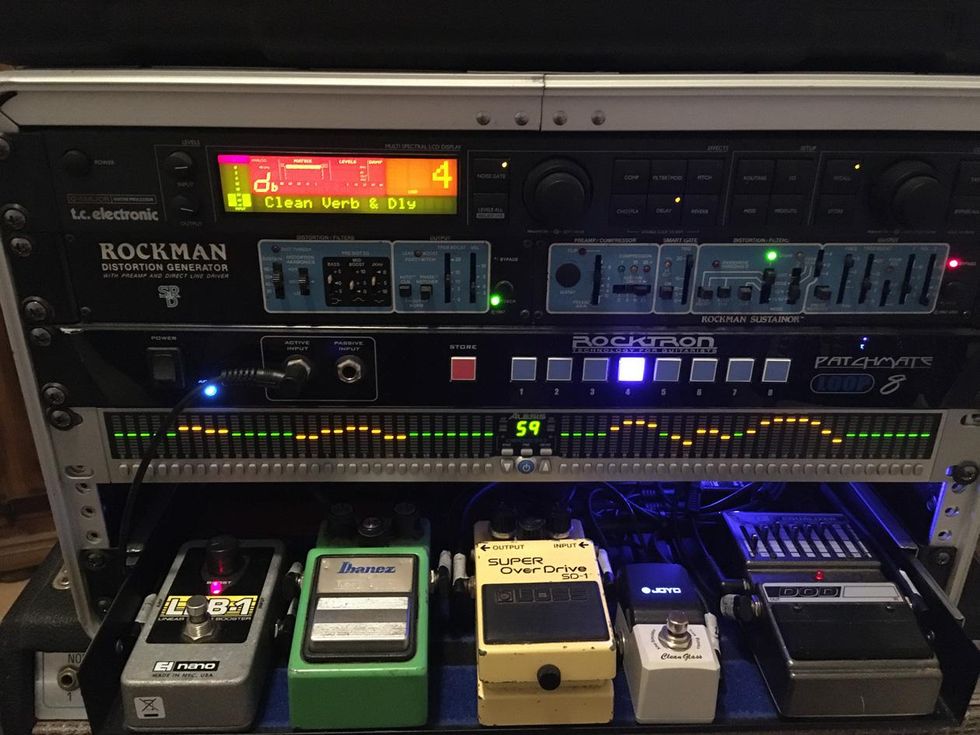
This is my rack configuration:
Electro-Harmonix LPB-1 Linear Booster, Ibanez TS9 (overdrive for the Strat), Boss SD-1 (overdrive for the Les Paul), Joyo Clean Glass preamp, DOD FX40B Equalizer, Rockman Sustainor (Strat crunch and leads), Rockman Distortion Generator (Les Paul crunch and leads), Rocktron Patchmate Loop 8, Rocktron MIDI Mate, Electro-Harmonix Expression Pedal, Dunlop Cry Baby Wah, TC Electronic G-Major effects processor, Alesis DEQ 2-channel Equalizer (pre- and post-Rockman EQ), and a Mooer Macro Power Supply. Going into the effects return (power amp) of my Fender Hot Rod Deluxe III.
JR Emmett: String Monkey

This is my humble submission for your Reader Pedalboard feature. This is my personal board, which serves as a demonstrator to my clients of what can be done with a pedalboard to make it convenient and versatile as well as supporting my own practice and performance needs. When I’m not playing guitar, I’m a one-man shop (String Monkey Technical Services) providing guitar repair and custom fabrication services to the North Texas music community.
Signal chain:
Wireless or cable -> Boss TU-2 -> General Guitar Gadgets Stratoblaster -> Boss BD-2 Blues Driver -> Dunlop 535Q Multi-Wah -> amp input
Amp FX send -> MXR Phase 95 -> Boss CE-5 Chorus -> Boss LS-2 (mixes signals from two Boss DD-3 Digital Delays run in parallel) -> Boss TR-2 Tremolo -> amp FX return
Other Features:
- Pedaltrain Novo 24 board
- Truetone 1 SPOT Pro CS7 Power Supply
- Built-in mic stand holder (upper right, repurposed flagpole mount)
- String Monkey patch bay with color-coded loom for easy signal hookup
- String Monkey repackaged amp-channel switcher (original was too big)
- String Monkey acrylic wah baseplate with mechanical clamp to Pedaltrain rails
- Talent DI Box with cabinet simulator and patch cables for direct to PA connection
- Soldered interconnect using Mogami bulk cable and Switchcraft phono plugs
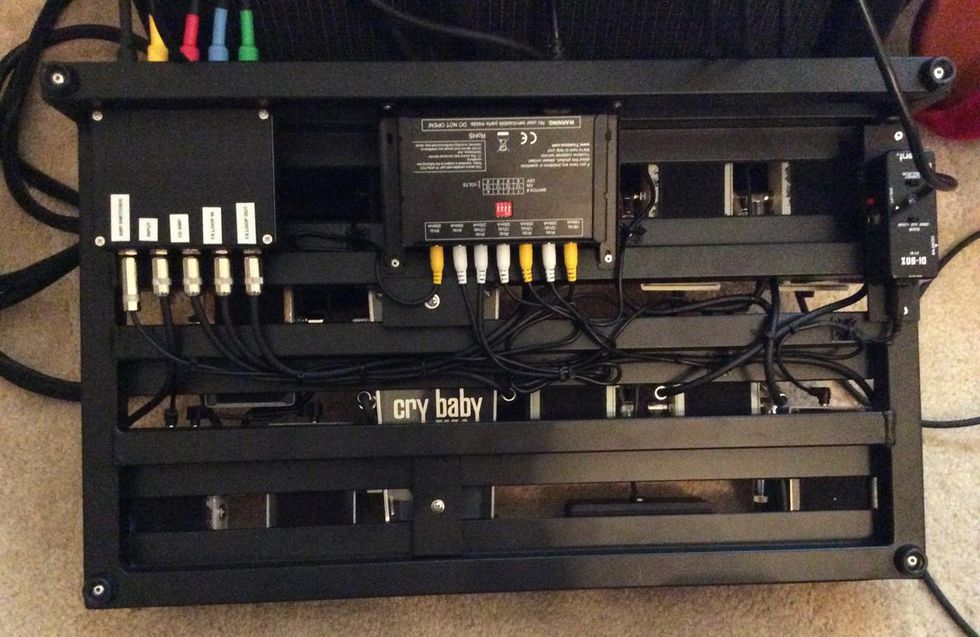
Keith Paul: Bass Board
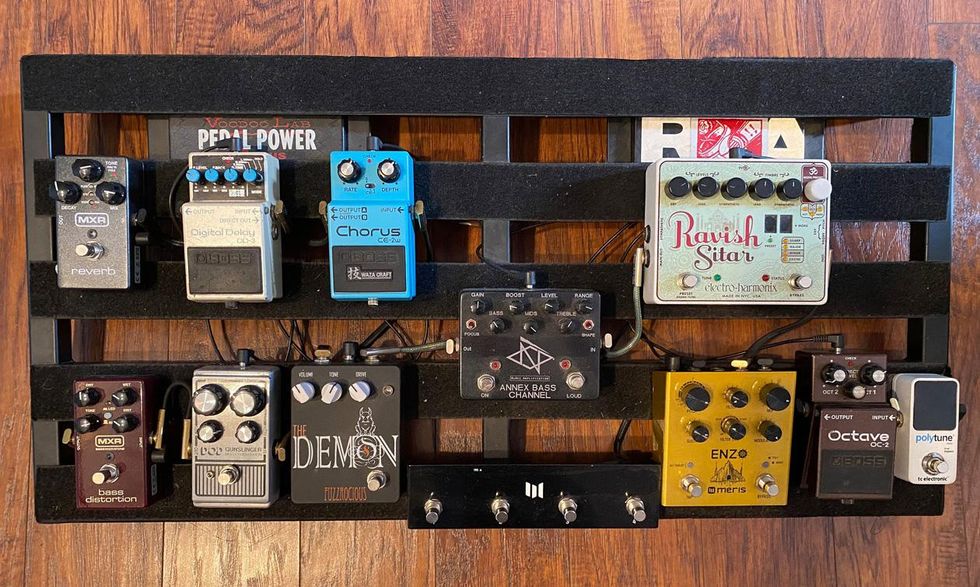
Hello PG! I just wanted to share my bass pedalboard that I use in my band Dumb Waiter, from Richmond, Virginia. Keep up the great content, I love the Rig Rundowns! Stay well.
Signal Chain:
- TC Electronic PolyTune Mini
- Boss OC-2 Octave
- Meris Enzo with preset switch
- Electro-Harmonix Ravish Sitar
- Nunez Amps Annex Bass Channel
- Fuzzrocious The Demon
- DOD Gunslinger
- MXR M85 Bass Distortion
- Boss CE-2W Chorus
- Boss DD-3 Digital Delay
- MXR M300 Reverb
Marco Fumagalli: Pandemic Pedalboard
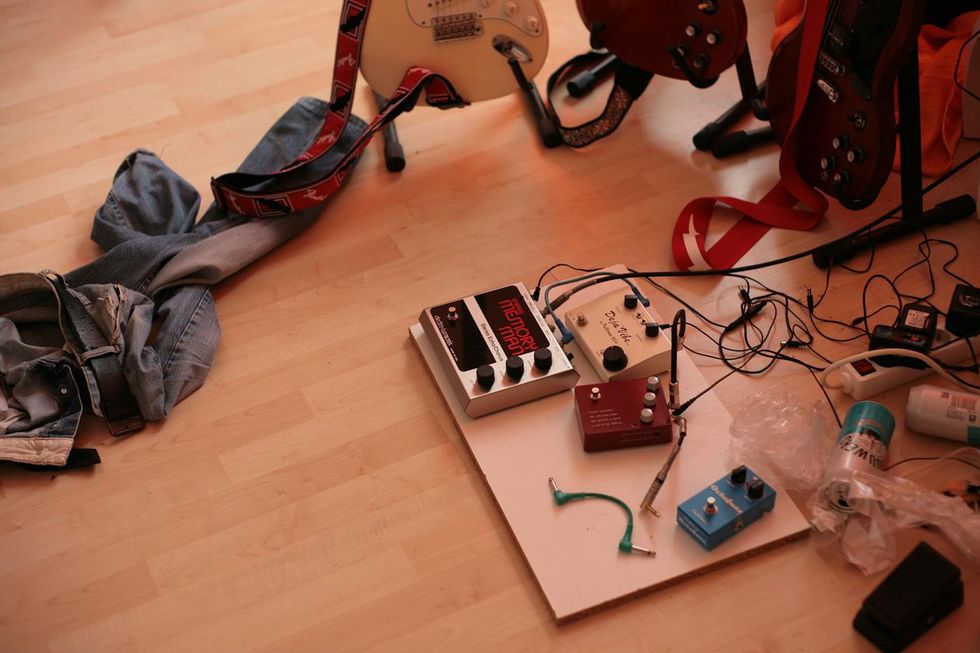
I am from Italy and living in Amsterdam, Netherlands. This is my pedalboard during the first wave of lockdown in 2020. I used to play in bands, but now I do it for my own pleasure. Playing the guitar and shaping the sound of it is a way for me to escape and relax. I don’t really play a specific type of music, but my root is blues.
Pictured: Electro-Harmonix Stereo Memory Man, Fulltone Mini Deja’Vibe, Klon KTR, Fulltone Octafuzz, Dunlop Cry Baby Mini Wah, two Gibson SGs, and a ’97 Fender Voodoo Strat from the greatly missed Mr. Soren Venema of the legendary Palm Guitars shop in Amsterdam.
Raghav Govindarajan: Nerding Out

I’m a huge fan of the Premier Guitar platform. My boss at the music school I work at and I frequently nerd out over the Rig Rundowns, so thank you for that! Figured I’d toss my pedalboard up. I have decided to update it since this photo, but my new pedals won’t be in until next week most likely.
The pedal chain from right to left is:
- DigiTech Drop
- Wampler Ego Compressor V2
- Dr. Scientist The Elements Distortion (Gold Bar Edition)
- Wampler Pantheon Overdrive
- Boss EQ-200 Graphic Equalizer
- Swindler Effects The Gulf Chorus V2
- Strymon Iridium
- Source Audio Collider Delay+Reverb
The output of the Wampler Ego goes into input A of the EQ-200, and output A goes into the Elements. The output of the Pantheon goes into the input B of the EQ-200, and output B goes into the Iridium. This lets me shape my sound pre- and post-gain.
Thanks for letting me nerd out about my board for a few minutes! And thank you for all that you do for the guitar community and musicians. Rig Rundowns really are the best part of my week/month and I love discovering new artists and players from it. It’s like the guitar player’s NPR Tiny Desk!
Robby Hovie: Going North
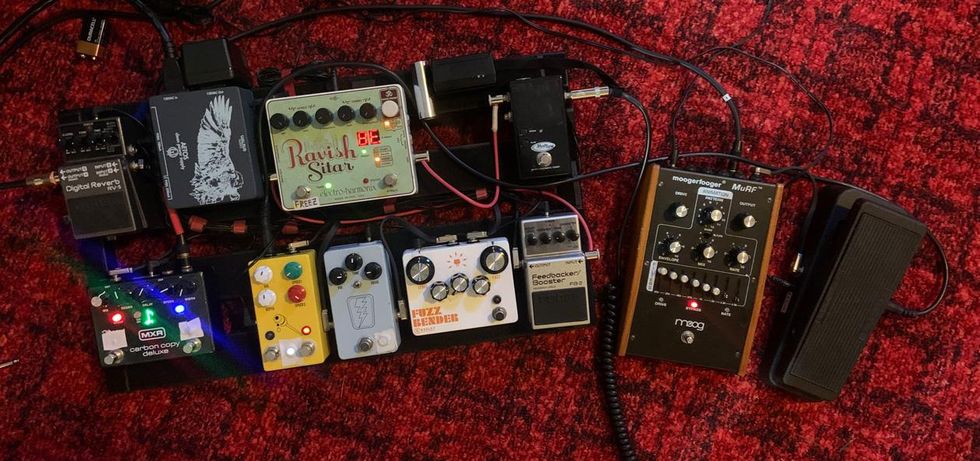
Greetings from Northern Michigan! Here’s my rig for my work in the band Levitator. Thanks!
In order:
- Modtone MT-PT1 Chromatic Tuner
- Electro-Harmonix Ravish Sitar
- Boss FB-2 Feedbacker/Booster
- Keeley Fuzz Bender
- JHS Pedals SuperBolt V1
- JHS Pedals Honey Comb Deluxe
- Dunlop Cry Baby Wah
- Moog MF-105 MoogerFooger MIDI MuRF
- MXR Carbon Copy Deluxe
- Boss RV-5 Digital Reverb
Sebastian DiPietro: The Full Package
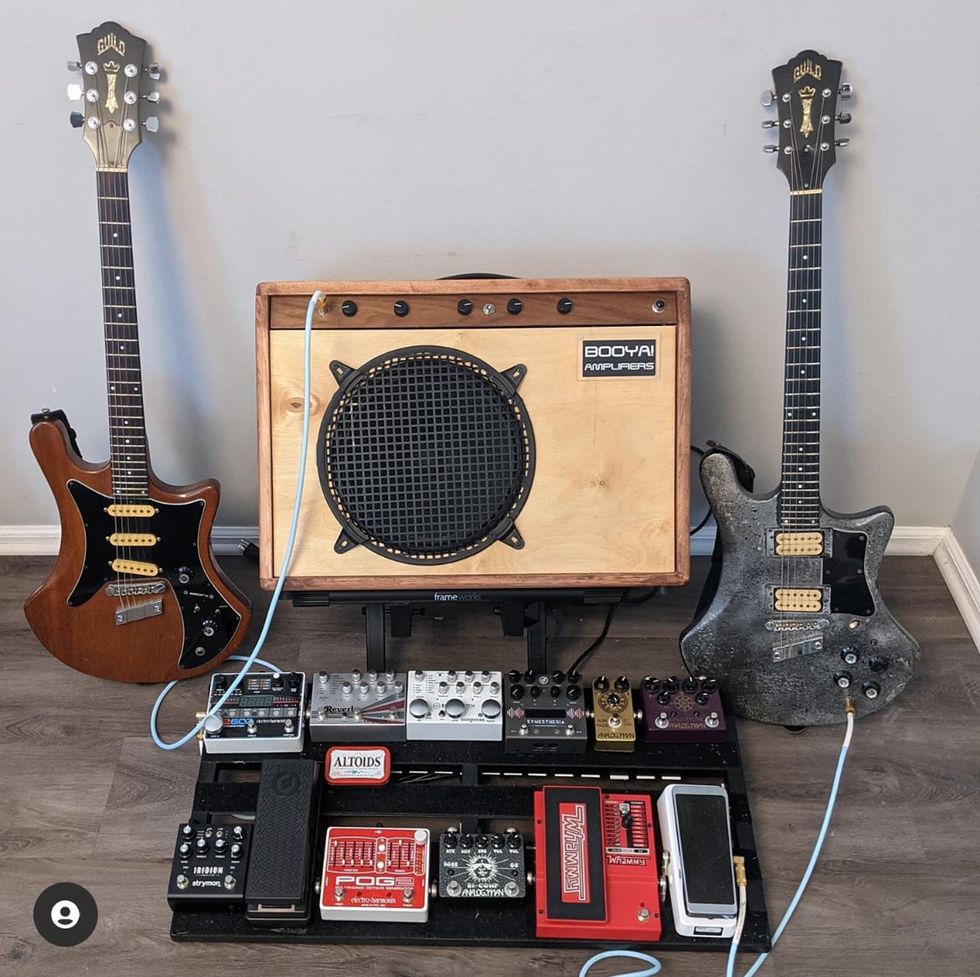
Here is a picture of my pedalboard, along with my amp and guitars, to give a complete view of my rig.
Pedalboard:
Xotic XW-1 Wah -> DigiTech Whammy V -> Analog Man Bi-CompROSSor Rev5 -> Electro-Harmonix POG2 -> Analog Man King of Tone -> Analog Man Sun Face BC109B -> GFI System Synesthesia -> Empress Effects Echosystem -> Empress Effects Reverb -> Electro-Harmonix 22500 Dual Stereo Looper -> Amp or Strymon Iridium
Guitars and Amp:
- Guild S70
- Guild S300D
- Booya! Amplifiers 27-watt combo with a Celestion G12H-75 Creamback
Cables:
- Caulfield Cables (light blue guitar/amp cables)
- Audioblast Cables (patch cables)
Steve Gorospe: All Styles
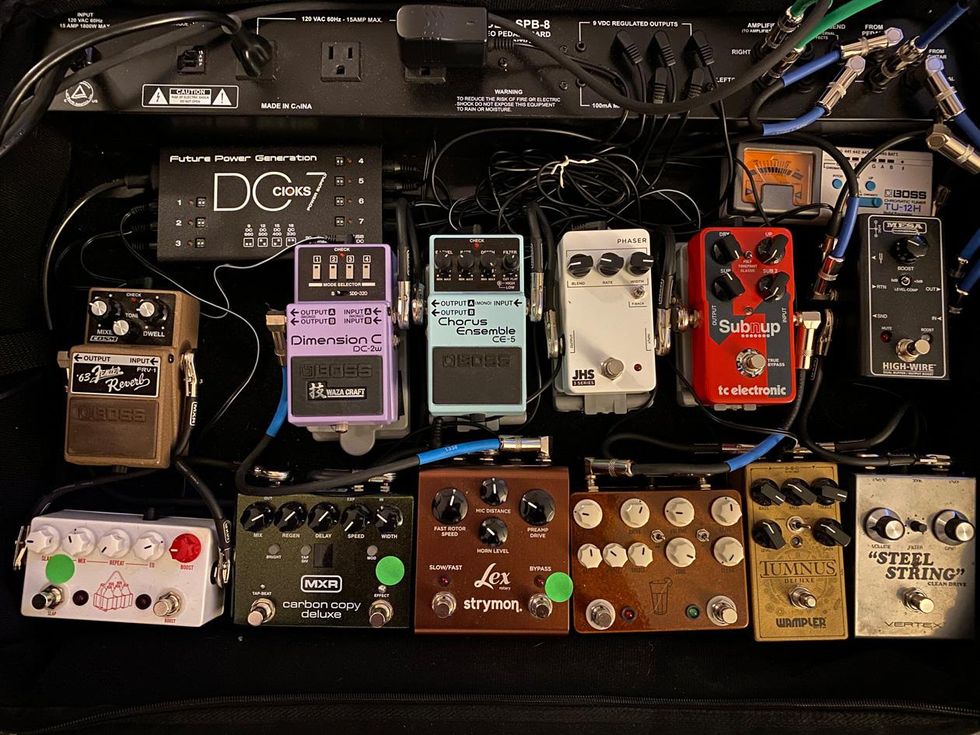
I play in the American Music Company Band covering songs from the 1940s to the early 1970s, with most of the focus on 1950s rock ’n’ roll and 1960s R&B and soul. But that also includes blues and some old-school country. I spent my teen years through the 1980s, so ’70s guitar rock and ’80s stadium rock are a huge part of my musical life. I built a pedalboard that works for me to cover all these styles and material.
Pedals in series in the order below:
- Vertex Steel String
- Wampler Tumnus
- JHS Pedals Sweet Tea V3
- TC Electronic Sub N Up Octaver
- JHS Pedals Series 3 Phaser
- Boss CE-5 Chorus Ensemble
- Boss DC-2W Dimension C Waza Craft
- Strymon Lex Rotary
- MXR Carbon Copy Deluxe
- JHS Pedals The Milkman
- Boss FRV-1 ’63 Fender Reverb
- Mesa/Boogie High-Wire Dual Buffer (input and output)
- Boss TU-12H High-Range Chromatic Tuner (hooked to the tuner output of the Mesa High-Wire)
Thomas Madera: Tribute to Eddie
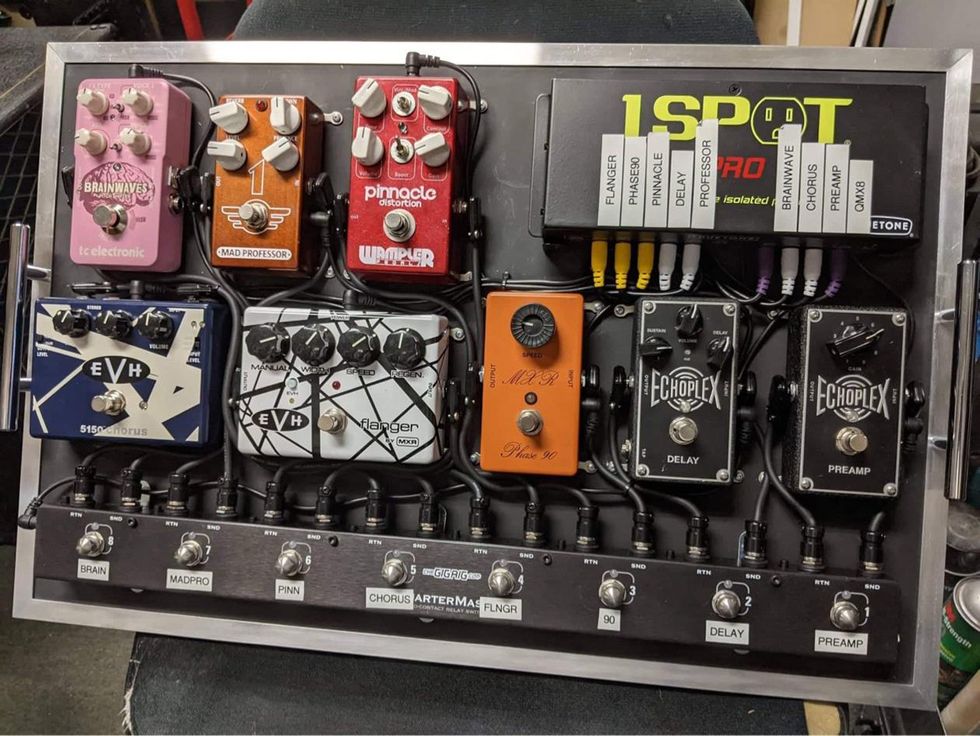
I’m a guitarist in Las Vegas, Nevada. My stompbox setup is mostly a tribute to Eddie Van Halen, but this board is great for tons of rock/metal tones, lead or rhythm. It includes: an Echoplex EP101 Preamp, Echoplex EP103 Delay, a reissue MXR Script Phase 90, MXR EVH117 Flanger, MXR EVH 5150 Chorus, Wampler Pinnacle Distortion, Mad Professor 1 Distortion/Reverb, and a TC Electronic Brainwaves Pitch Shifter. Everything is routed into a GigRig Quartermaster QMX 8 switcher and powered by a Truetone 1 SPOT Pro CS12.
